This is the website of Abulsme Noibatno Itramne (also known as Sam Minter).
Posts here are rare these days. For current stuff, follow me on Mastodon
|
States with new poll data added since the last update: All 50 states, and DC. Notable changes in the tipping point plus New Mexico, Maine (at large), Kansas, and Missouri.
National Summary
With the latest batch of updates, there was a lot of churn that caused some big movements if you look at the charts. For a while as I entered polls it looked like Trump’s peak was definite and a clear downward trend was in place, even before the debate. But then as I continued to enter polls, most of those Clinton gains were reversed.
The primary reason for this? Florida [29 EV], Ohio [18 EV], and North Carolina [15 EV] are all currently very close in my averages. Close enough that single polls can move them back and forth across the center line. As I worked through this round of poll updates, all three of these states moved from Weak Trump to Weak Clinton and back again. Now, the actual changes in the averages in these three states were not much. They just happened to pass the zero line, and have large numbers of electoral votes.
So if you look at the “Expected Case” chart for the electoral college, you see a big move toward Clinton, then a big reversal a few days later. Because of the nature of the electoral college, you should expect (and be careful interpreting) large electoral college moves like this so long as there are big states that are close. In these cases looking at the tipping point provides a different view with a bit less volatility.
In any case, looking only at the final net change from this round of polls, we see these changes in the national picture:
- The expected case moves from Clinton by 8 EV to Clinton by 6 EV
- Clinton’s best case improves from Clinton by 188 EV to Clinton by 208 EV
- Trump’s best case declines from Trump by 106 EV to Trump by 92 EV
- The tipping point moves from Clinton by 0.1% in KS to Clinton by 1.3% in NH
Now, this round includes a handful of post-debate polls, but almost all of the movement discussed here comes from before the debate. (The exception is Florida returning to Weak Trump after the debate.)
Looking at the charts…
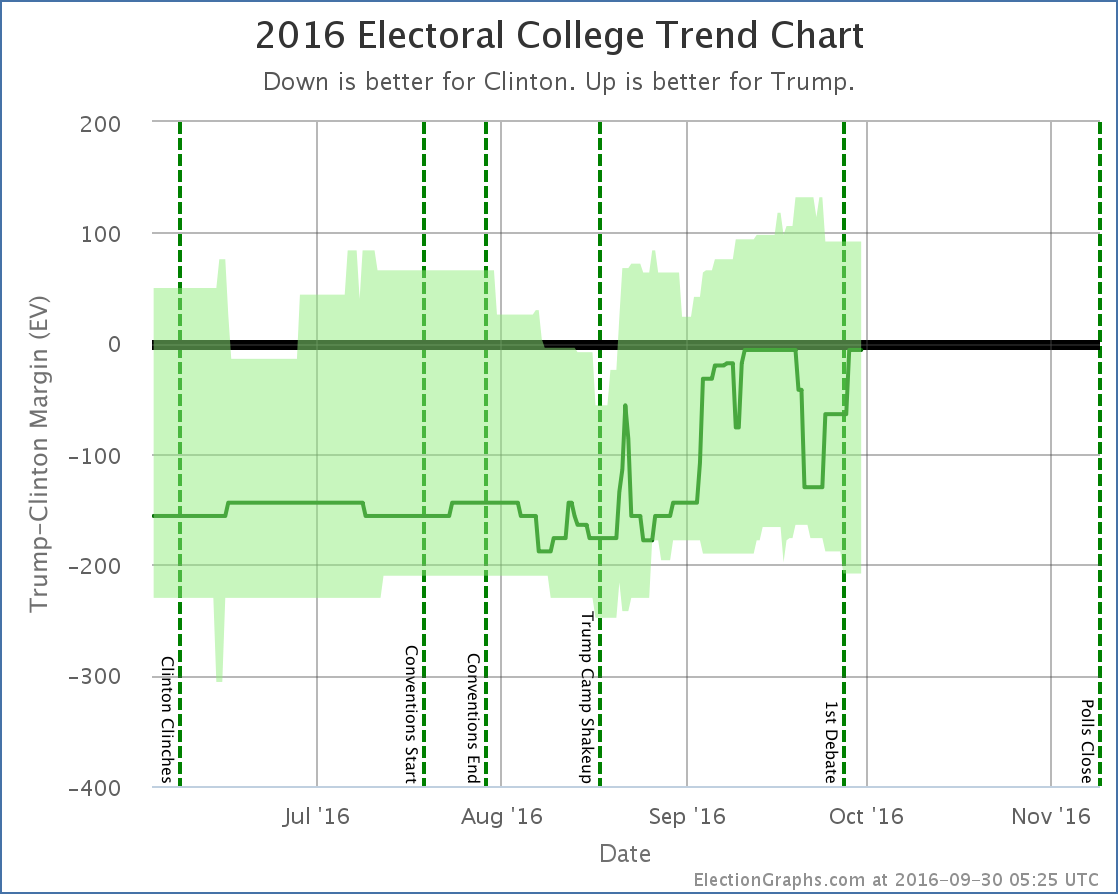
Notice the clear dip from about September 19th to September 28th when Florida, Ohio, and North Carolina went slightly blue, then moved slightly red again. In the end, the “expected case” remained flat. The movement Clinton saw from winning by 6 electoral votes to 8 electoral votes in the last update was erased by New Mexico and Kansas both returning to their “normal” colors.
Both “best cases” moved toward Clinton though, with New Mexico and Maine at large both moving out of Trump’s reach, while Missouri moved into Clinton’s reach.
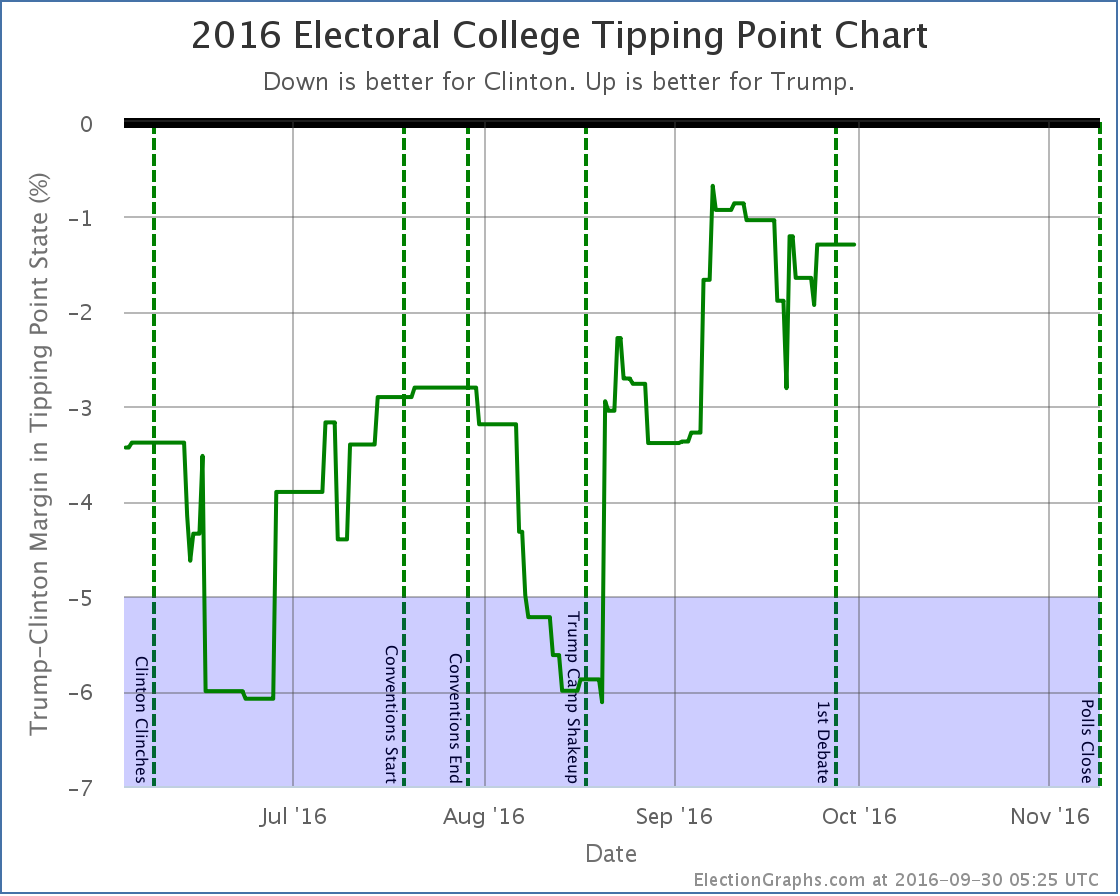
The tipping point chart doesn’t end up with huge moves when big states cross the center line, so it might be a better chart to look at right now to see how the race is moving. What we see is that after big gains starting with Trump’s campaign shakeup on August 17th, Trump seems to have peaked around September 7th… way up from where he had been, but never actually taking the lead… and he has been on a slow decline ever since… but we haven’t yet seen a BIG move back toward Clinton.
By most reports, Trump did badly in the debate, and has been doing things counter-productive to his campaign since the debate. But this does not mean large numbers of people have changed sides. Maybe this will happen, maybe it won’t, but the small number of post-debate polls already included here don’t yet show it. (In fact, as I mentioned, the single state category change post-debate so far is a move toward Trump.)
Additional post-debate polls are coming in quickly now, but I had to cut off the round poll updates somewhere to get this blog post out. There will be another update soon enough, and we’ll start to see a bit better what (if any) lasting change comes out of the first debate. Of course just about as soon as there has been enough time to see that in the polls, it will be time for the next debates…
39.4 days left until polls start to close.
State Details
For those digging into the details, here are the charts for all the states influencing the analysis above:
The big close states:
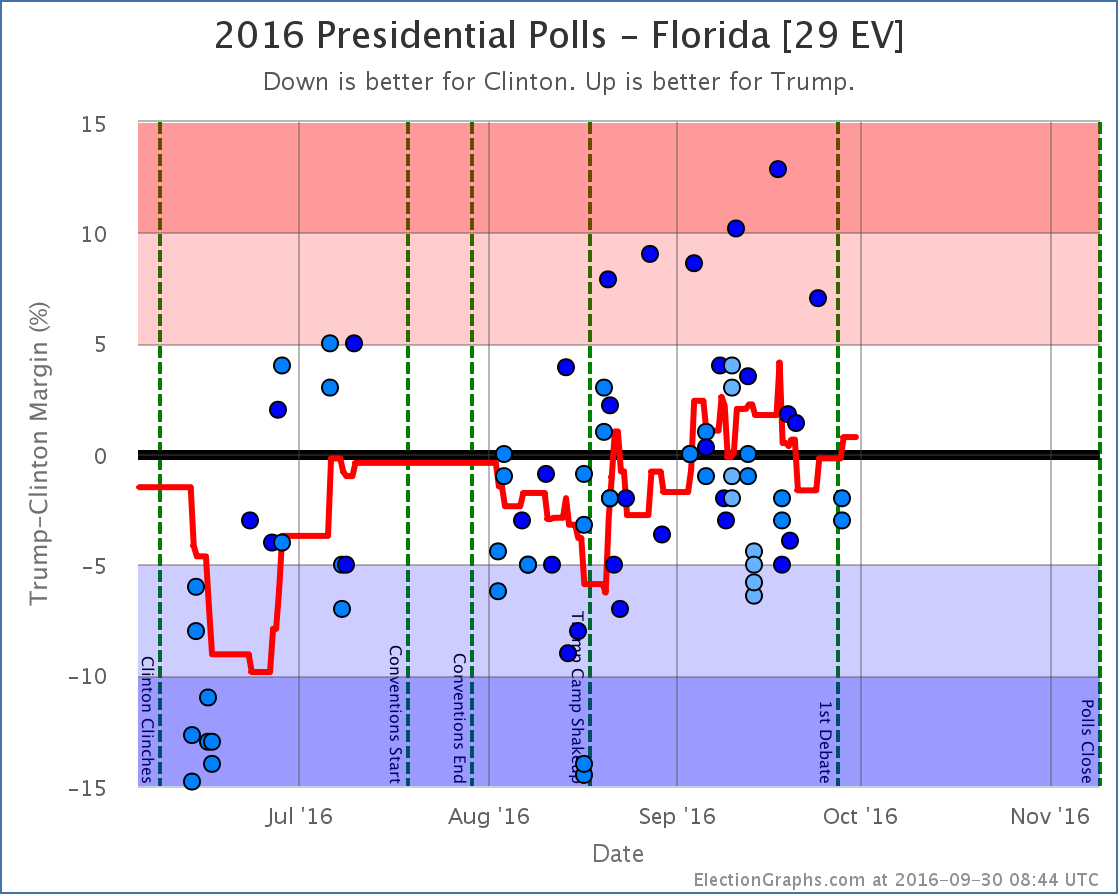
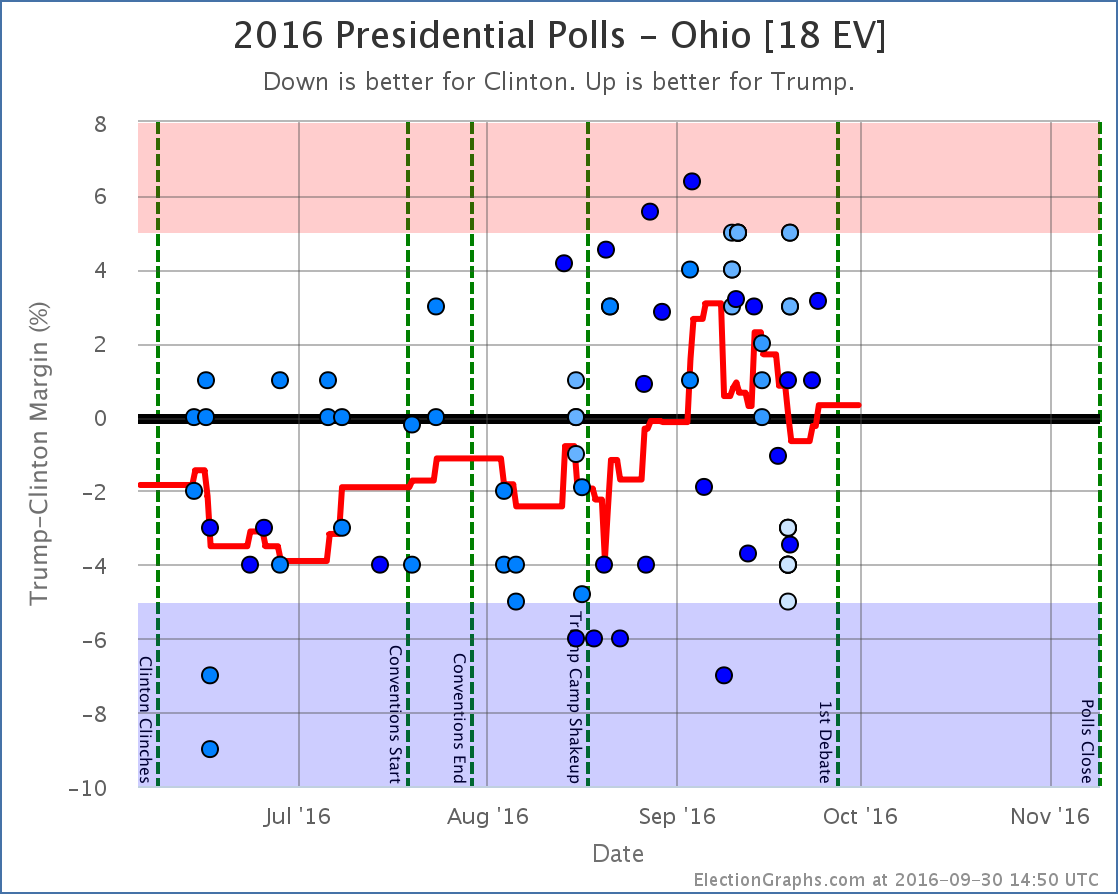
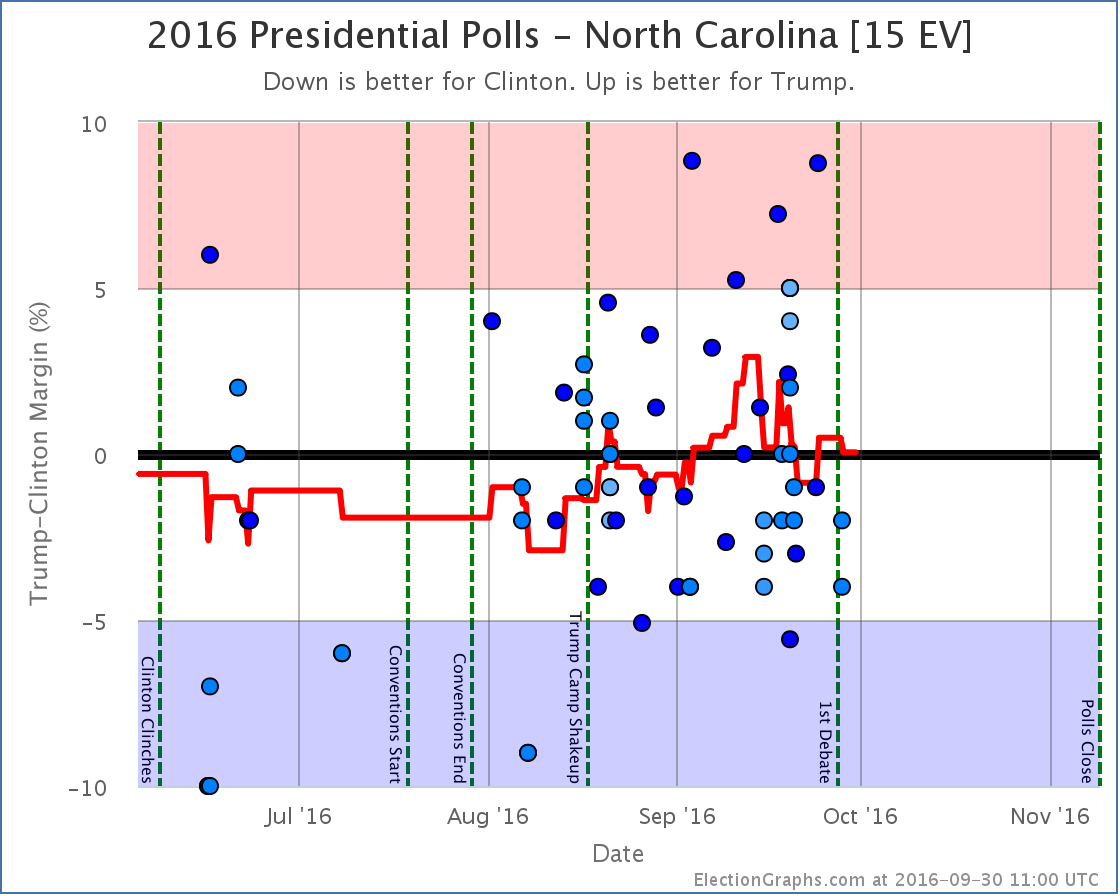
Weak Clinton to Weak Trump
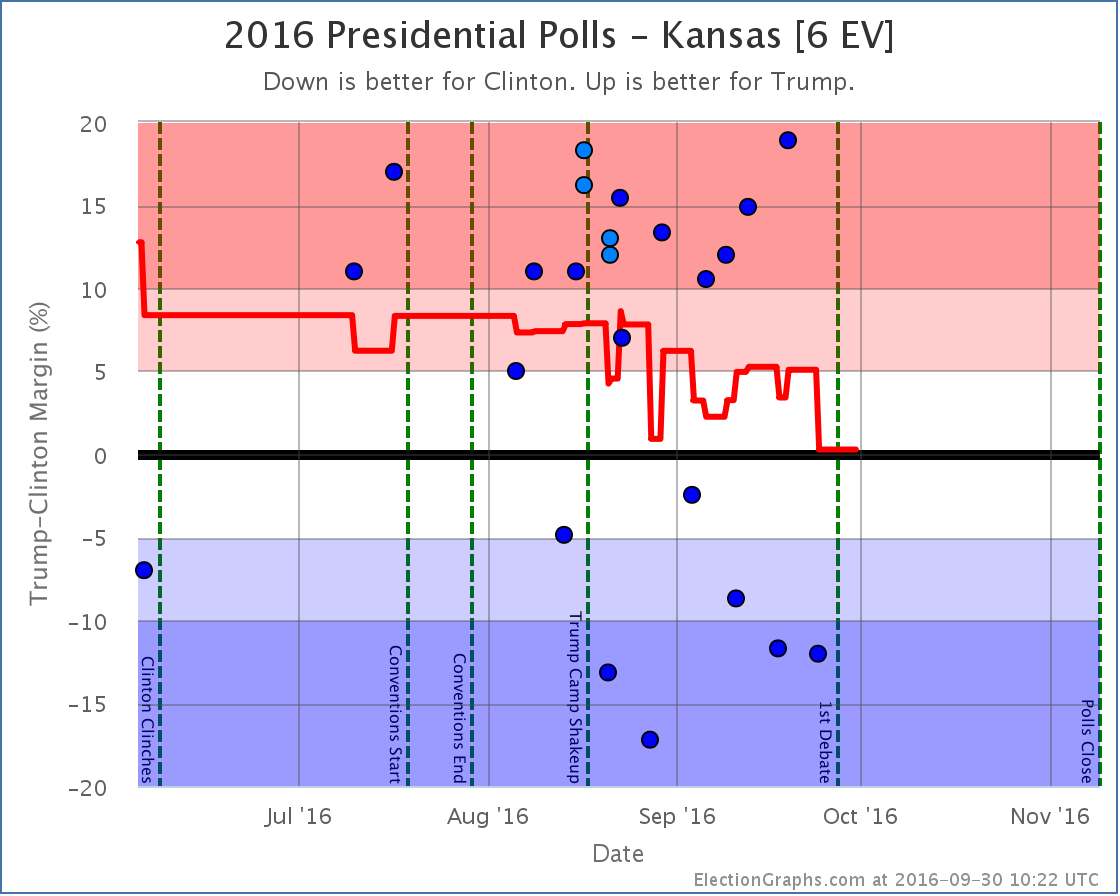
Strong Trump numbers from Ipsos and CVoter balance out the strong Clinton numbers from Google and leave us with an essentially tied Kansas and erase the short blue period for the state I noted last time. (The Ipsos and CVoter results came out later, but covered an earlier time period, so they moved the lines in the past, not just the current number.)
As I stated last time I am incredulous about the Google numbers, and wish there was more additional polling in Kansas to clear up what is really going on there.
Weak Trump to Strong Clinton
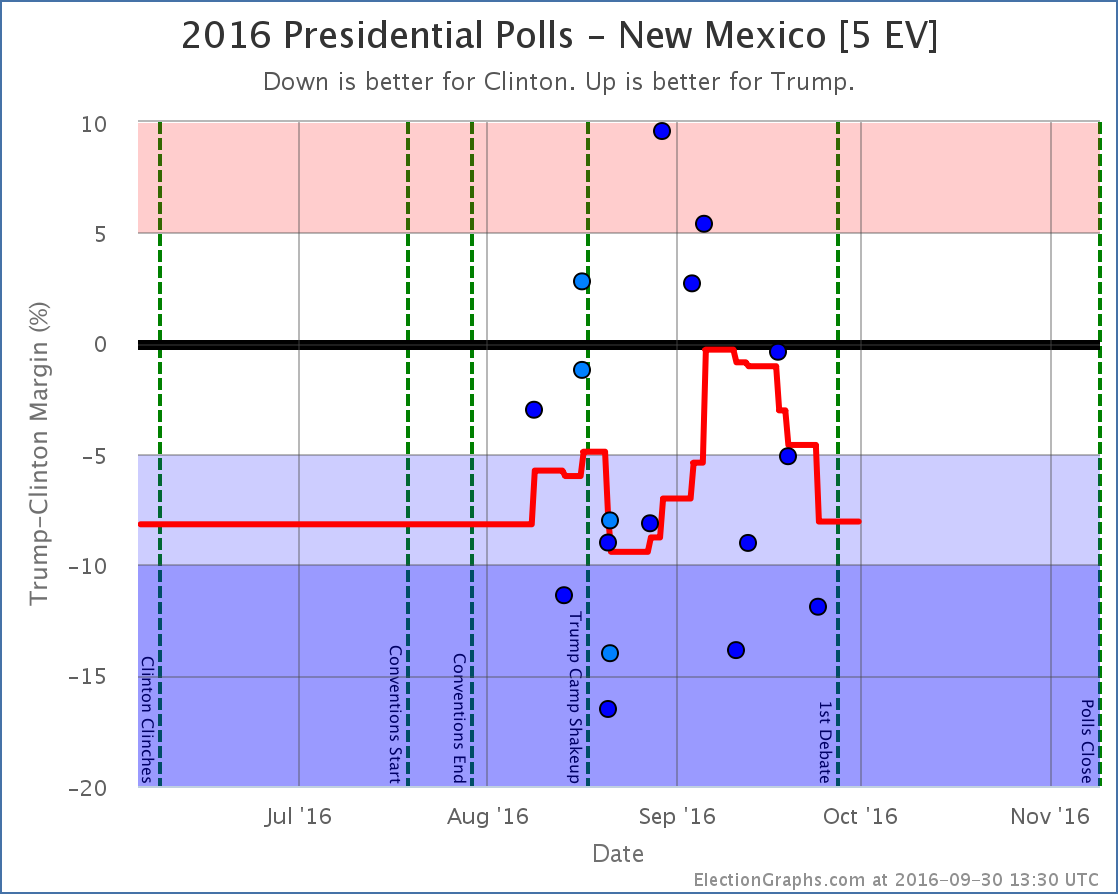
New polls in New Mexico erased the short foray into red territory for New Mexico. As with Kansas, since some of the “new” polls covered older date ranges, the shape of the curve in the past changed as well as the current number.
Strong Trump to Weak Trump
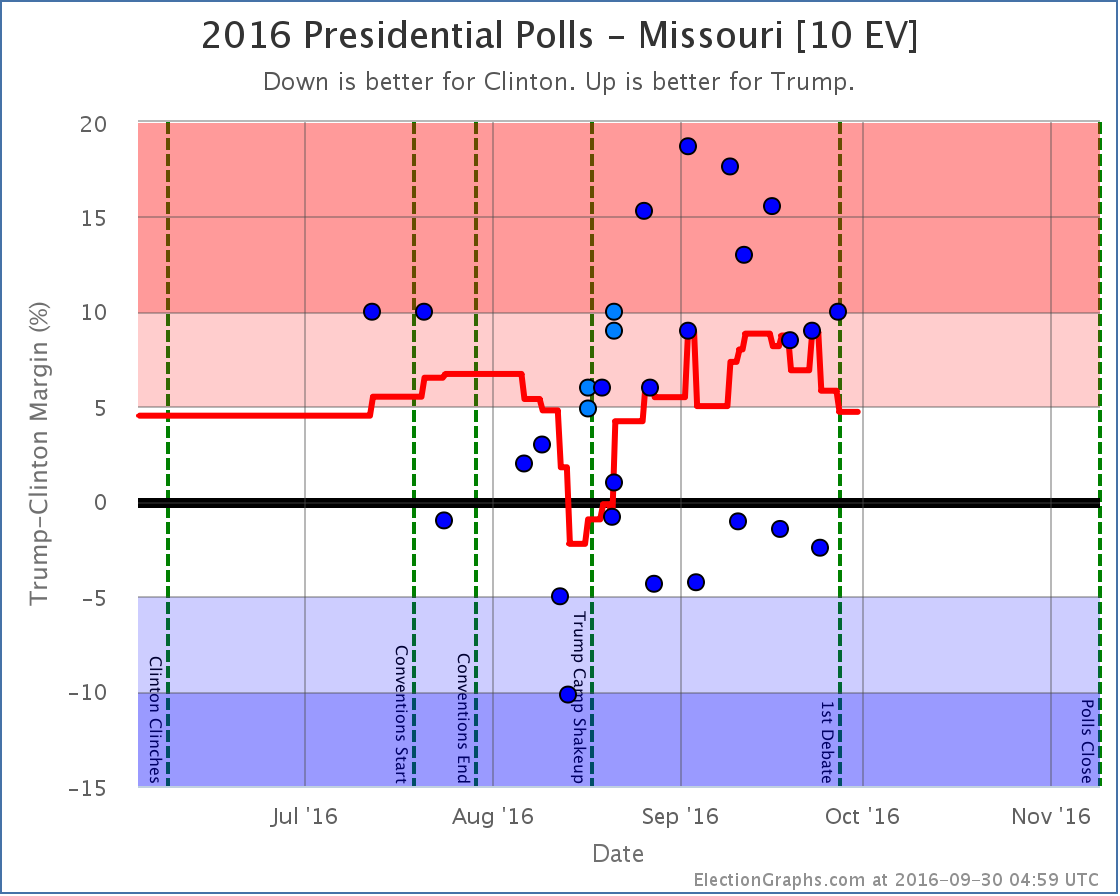
Weak Clinton to Strong Clinton
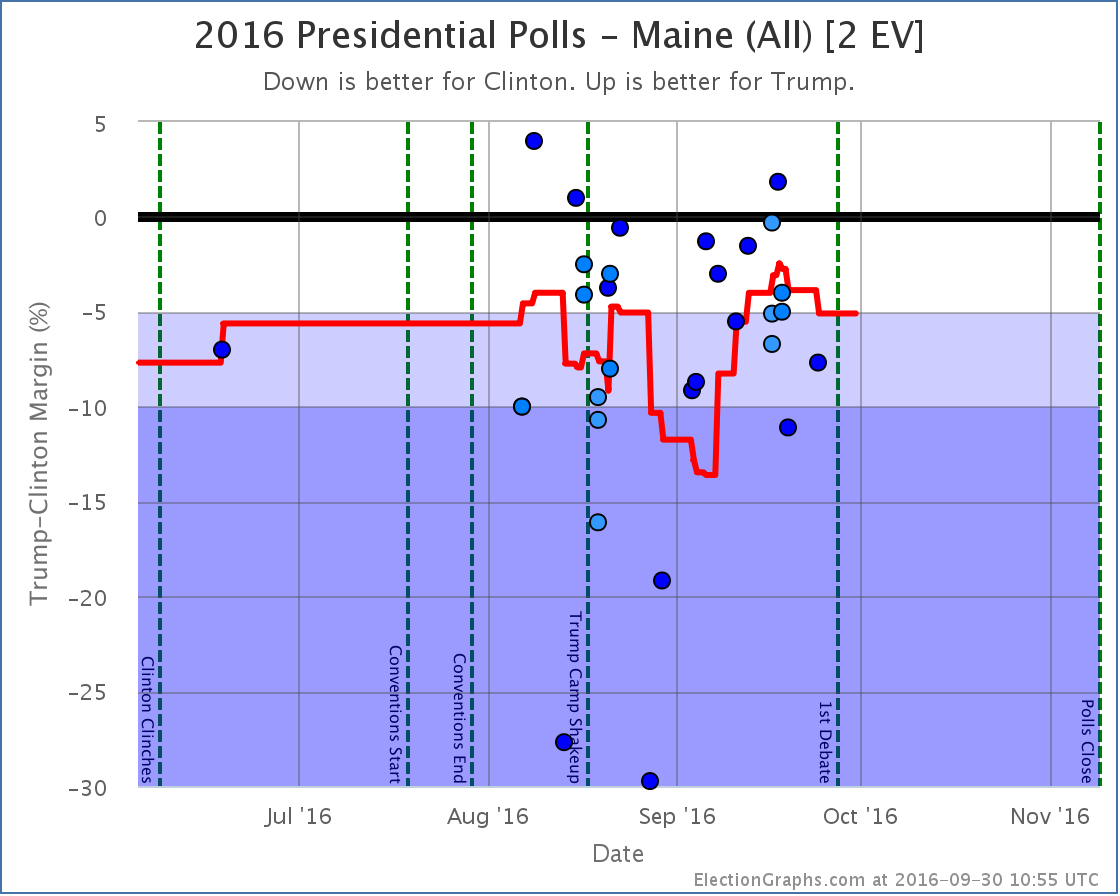
Other states that influenced the Tipping Point
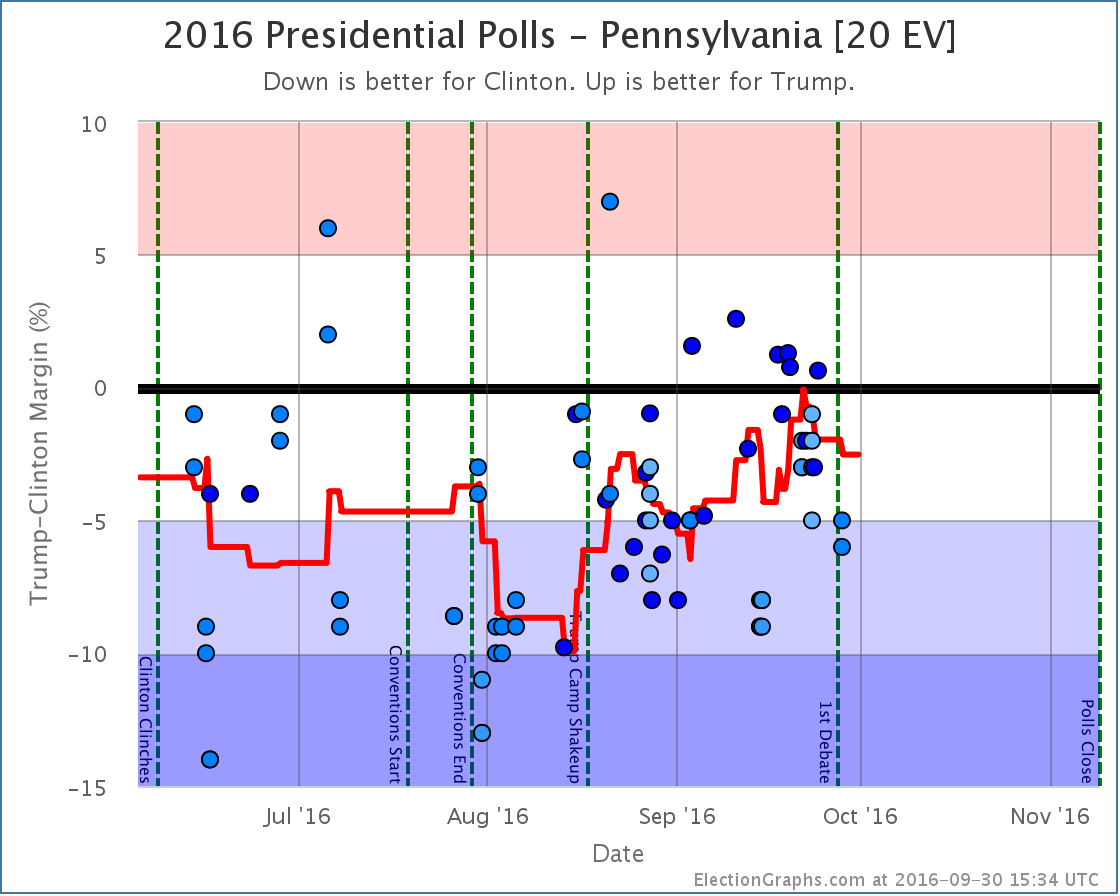
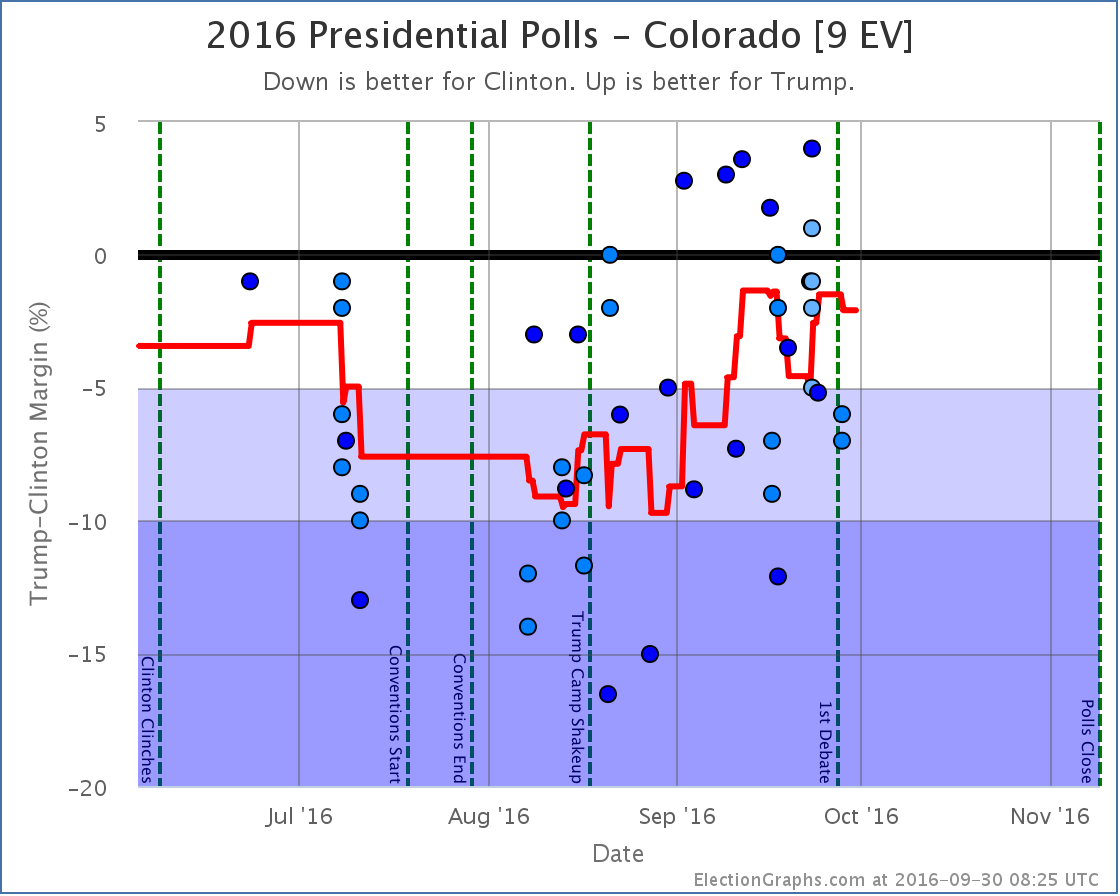
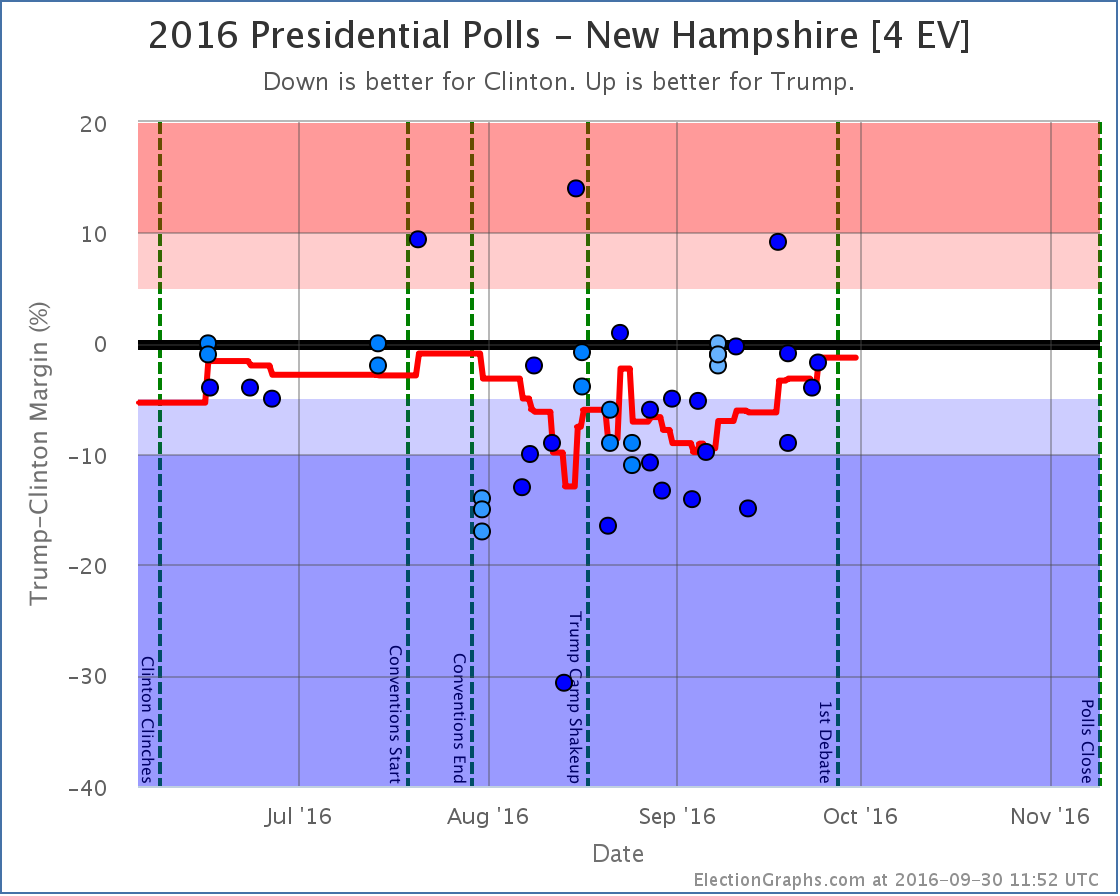
Note on placing polls on the timeline
I somehow forgot to mention this in my recent interview about this site, but it seems relevant to the discussion above… Many other election tracking sites place polls based on the END of the poll’s time in the field. I place polls on the timeline based on the mid-date of their time in the field. I think this does a better job at trying to identify when directional changes happen, because if an event and a mid-date are aligned, you know that the poll was half before and half after the event. When you place polls by the end of their field time, you can’t make any sort of statements like that about how the poll results match up with the event without referring to the specific start and end dates.
For more information…
This post is an update based on the data on ElectionGraphs.com. Election Graphs tracks both a poll based estimate of the Electoral College and a numbers based look at the Delegate Races. All of the charts and graphs seen in this post are from that site. Additional graphs, charts and raw data can be found there. Follow @ElectionGraphs on Twitter or like Election Graphs on Facebook to see announcements of updates or to join the conversation. For those interested in individual general election poll updates, follow @ElecCollPolls on Twitter for all the polls as they are added. If you find the information in these posts interesting or useful, please consider visiting the tip jar.
Edit 2016-10-01 00:34 UTC to correct the one state that moved after the debates. I had said it was North Carolina moving back from Weak Clinton to Weak Trump, it was actually Florida.
States with new poll data added since the last update: All 50 states, DC, and the Maine congressional districts. Notable changes in Kansas, New Hampshire, New Mexico, and Maine’s 2nd Congressional District.
National Picture
The update today is a strange one. Some indicators move toward Clinton, others move toward Trump. Some of the moves seem to be prompted by outlier data as well, so some skepticism is probably in order. But with the directional mix, one possible conclusion is that we are at or near the top of the recent move toward Trump. As I write this though, we are hours away from the first debate, which may well scramble things again.
The summary changes:
- The expected case moves from Clinton by 6 EV to Clinton by 8 EV
- Clinton’s best case improves from Clinton by 178 EV to Clinton by 188 EV
- Trump’s best case improves from Trump by 98 EV to Trump by 106 EV
- The tipping point moves from Clinton by 0.8% in NM to Clinton by 0.1% in KS
So two moves in Clinton’s direction (Expected and Clinton Best), and two moves in Trump’s direction (Trump Best and Tipping Point.)
The charts look like this:
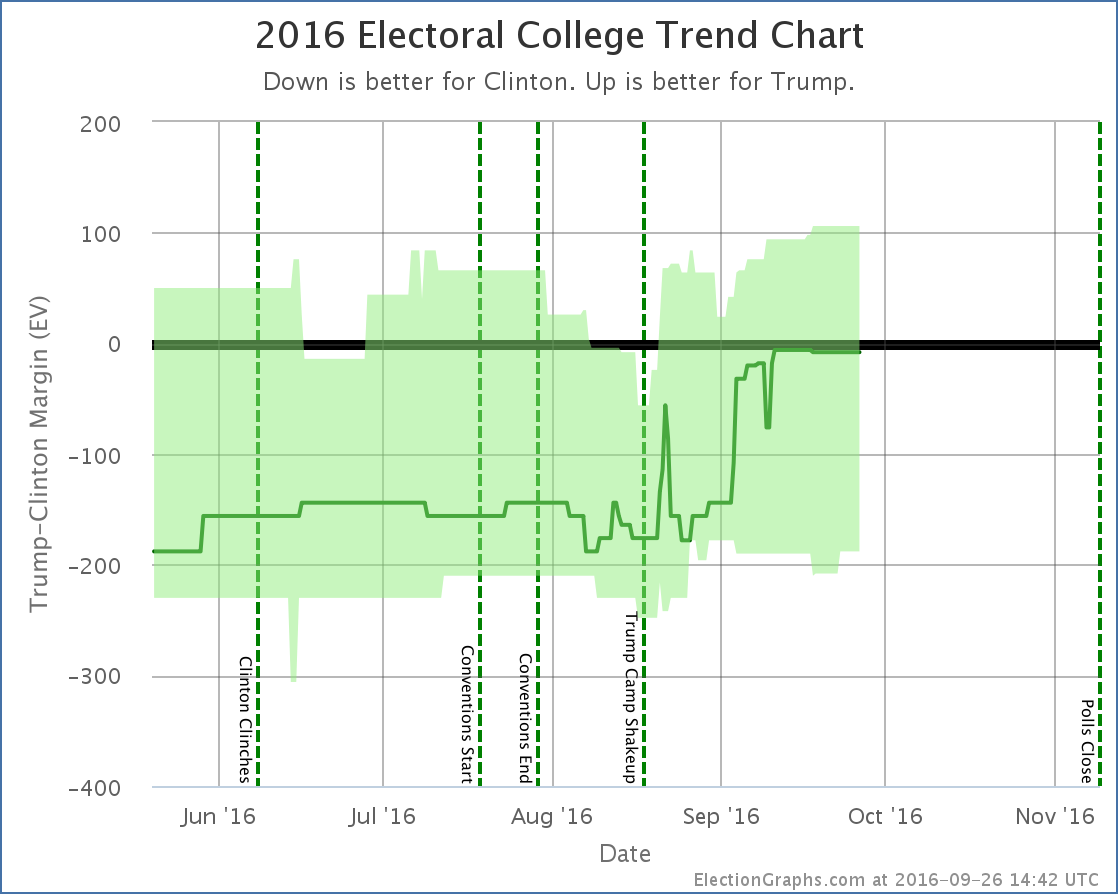
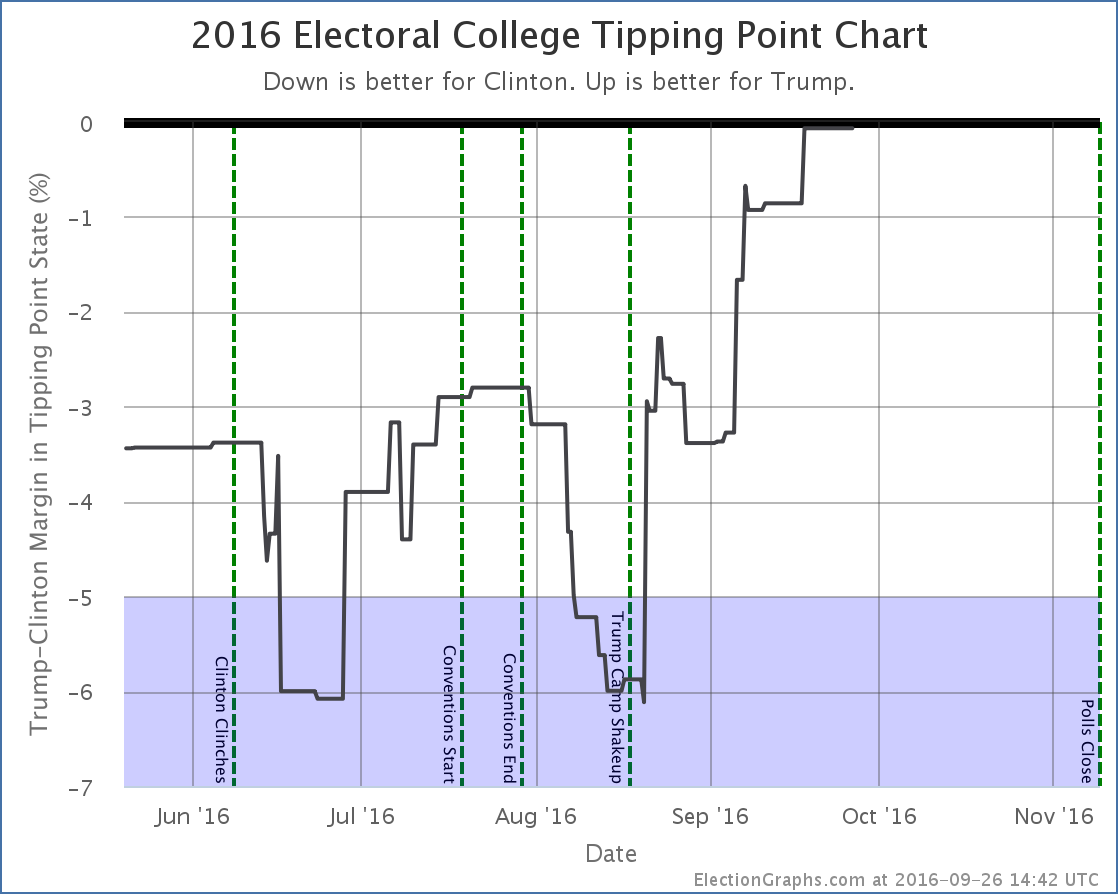
I’ve added a new vertical line marking the moment when Trump shook up his campaign by bringing in Steve Bannon and Kellyanne Conway. Looking back, we can now see this very closely aligns to the moment Trump stopped dropping and started closing the gap with Clinton.
Trump has still not led in my model, but this is about as close as you can get without crossing that line.
The fact that we are now seeing simultaneous moves in both directions might indicate we are near the top of this particular trend toward Trump. But events have the potential to change things quickly… in either direction.
43.4 days until polls start to close on election day…
State Details
For those who are interested in the individual state moves that combine for the national changes above, here they are. I will only add individual commentary when there is something specific worth noting.
Flipping to Clinton
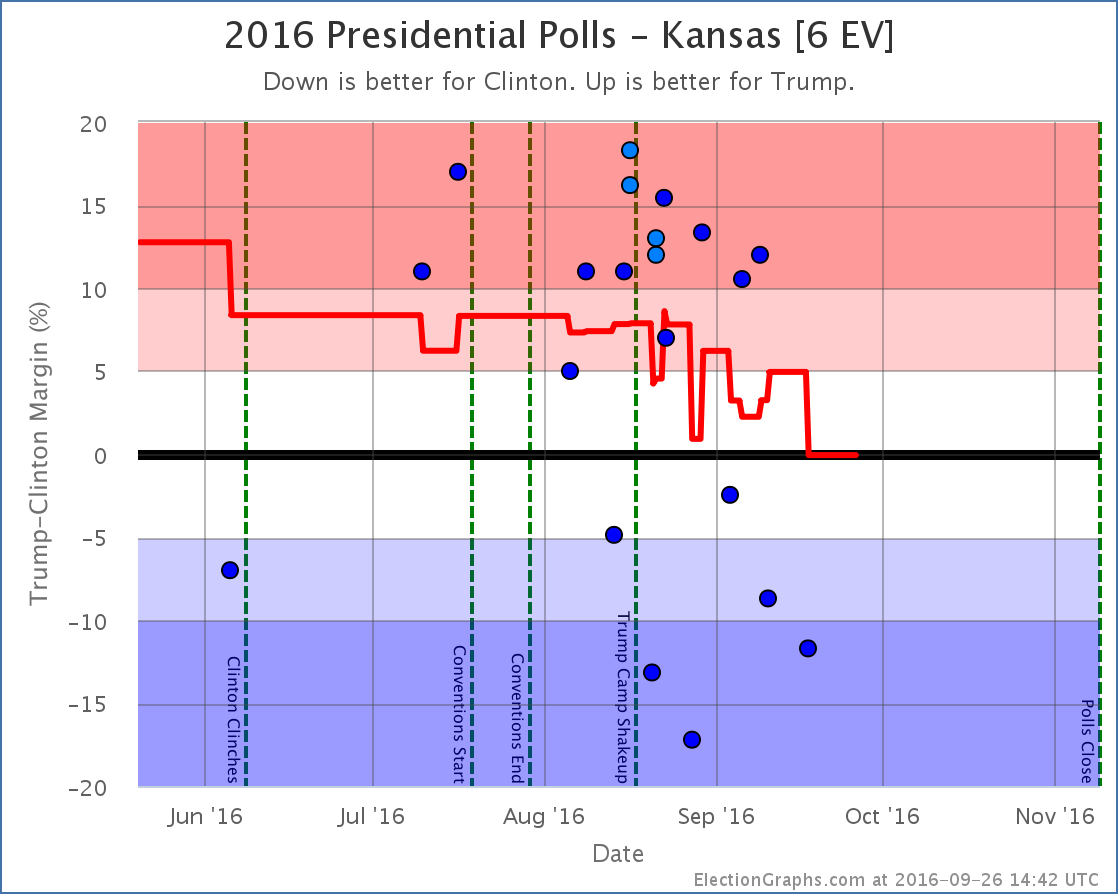
I’m putting this one first, because it is one I honestly don’t believe. Every single one of the results showing Clinton ahead since August is from one pollster… Google Consumer Surveys. This pollster has some unorthodox methods, and has produced strings of outliers in a wide variety of states… some favoring Trump, others favoring Clinton. In this case, other than a single Zogby poll in June, every other pollster shows Kansas not only favoring Trump, but favoring Trump by a substantial margin.
Because I am inclusive and try not to exclude polls, three of the five polls in my average in Kansas are from Google at the moment. This leads to a 0.1% Clinton lead in Kansas. If you excluded the Google polls, my average would show Trump leading by 11.6%. I am very very dubious that Kansas is even a close state, let alone that Clinton is ahead. We need more non-Google polls in Kansas to clear up this situation.
Now, astute observers will note that if you flip Kansas back to red, Trump would actually now be leading in the “expected” result. But not so fast. Google causes changes in other states too. To pick out one prominent example, Google has been giving Trump much bigger leads than other pollsters in Florida. My average in Florida currently shows Trump up by 1.1%, but if you removed Google, the average moves to Clinton by 1.3%. So removing Google might flip Kansas, but it would also flip Florida. You’d still have a Clinton lead overall, just in a different way.
The philosophy of this site is to just include everything unless is it obviously fake or fraudulent. The Google polls may be bad… they are just all over the place compared to more traditional pollsters… but they are not an obvious fake or fraud. So I will continue to include them. I don’t pick and choose polls based on if I “believe” them. Google is in the average. So you end up with a very slight Clinton lead… in Kansas.
But Google is clearly adding noise to the model at the moment… which I’m not particularly thrilled about.
Note that Kansas moved all the way from Strong Trump to Weak Clinton in one jump, so it improved both Clinton’s expected case and her best case.
Flipping to Trump
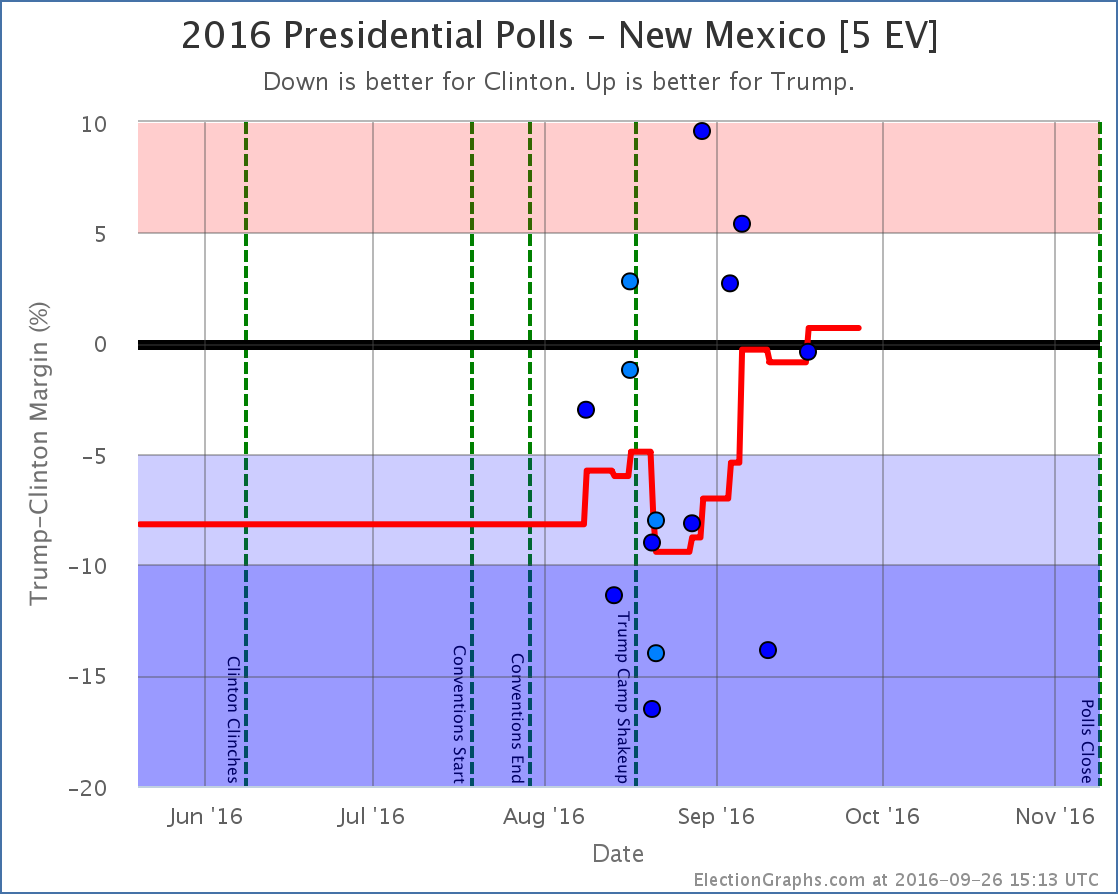
This is another state where three of five data points in my average are from Google, and this time the other two are from Reuters/Ipsos, another “50 state” pollster where the numbers can sometimes be way out of line with other polls. In this case Google and Ipsos seem to trend in opposite directions, but it would be really nice to have some other big name pollsters check out New Mexico again before too long, because when all you have are these polls looking at the whole country and then breaking out subsamples by state, you really have a lot of uncertainty on the results. So like Kansas, treat New Mexico with a substantial pile of salt.
Now in reach for Trump
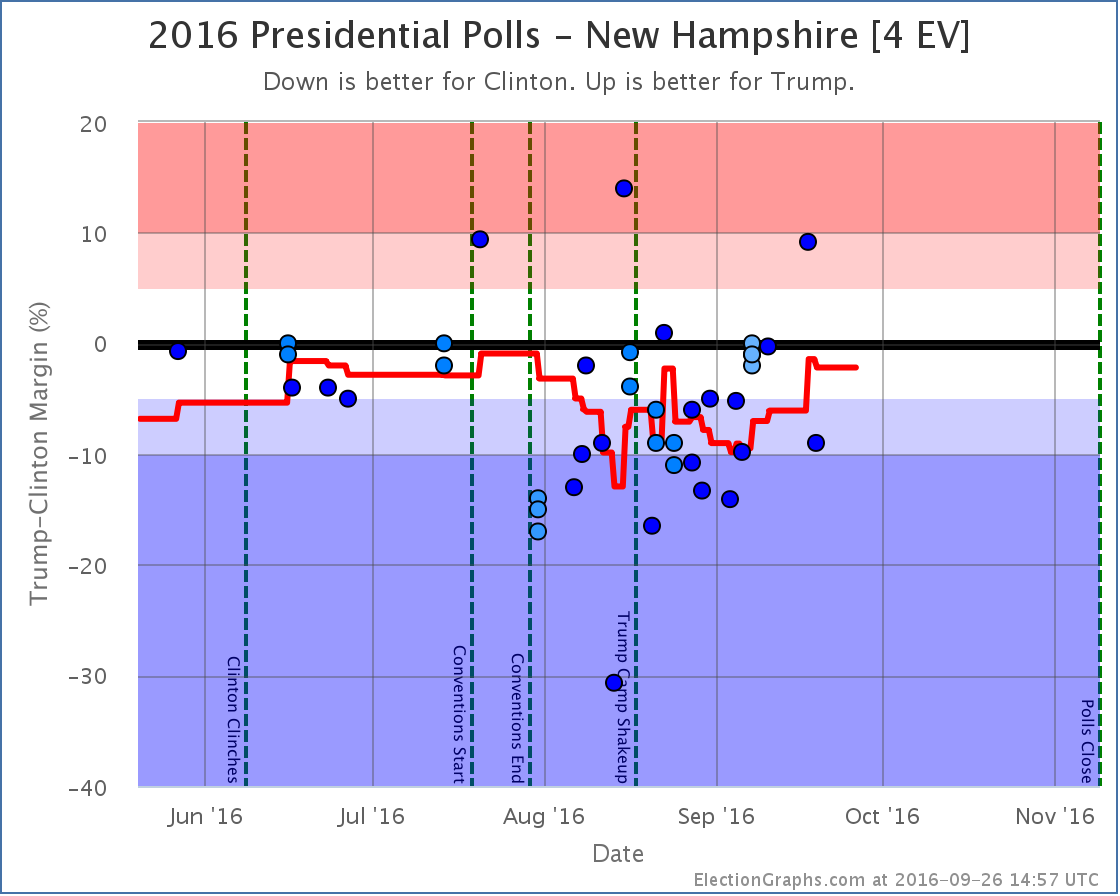
No longer in reach for Clinton
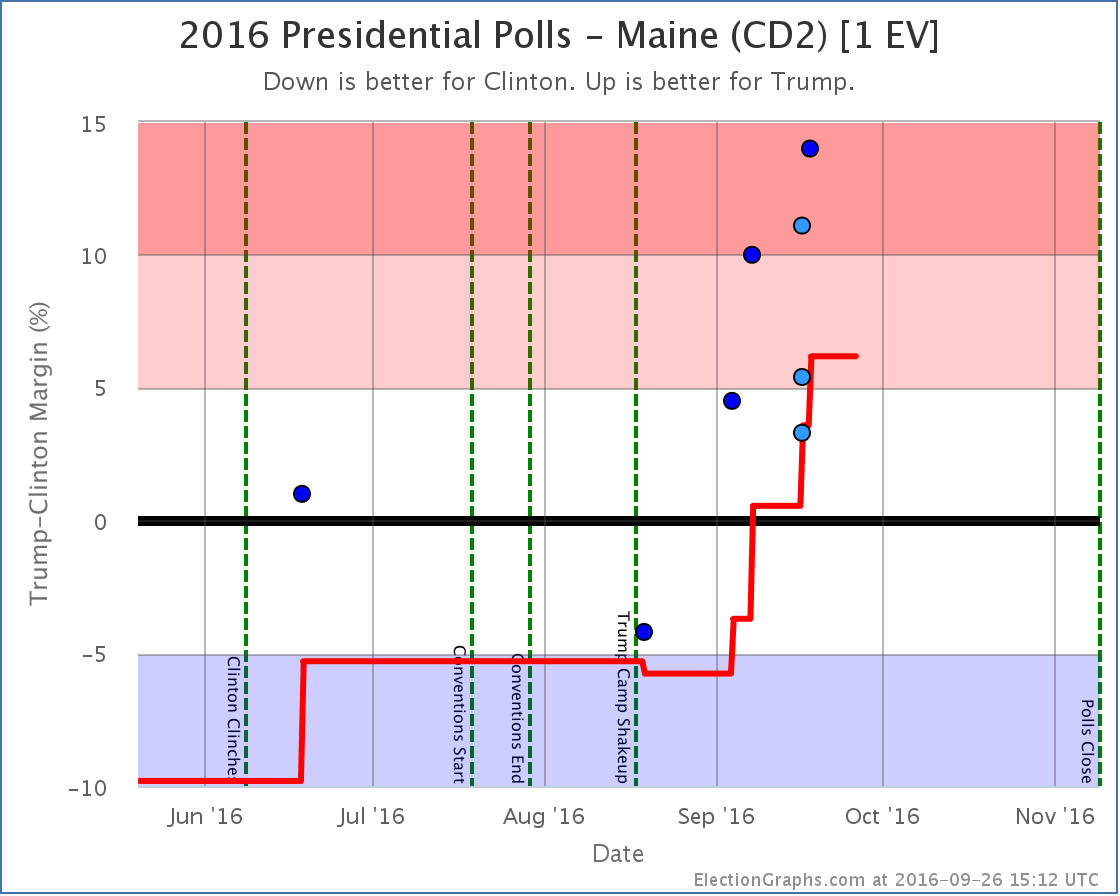
Interview
The latest Curmudgeon’s Corner podcast presented interviews with three people who do independent electoral college projections based on state polls… Luis Mendez from projectiondesk.com, Darryl Holman from horsesass.org, and me… Sam Minter from electiongraphs.com. We each talked about how we got into this sort of analysis, what makes our sites different, the challenges we face, and more. Take a listen!
For more information…
This post is an update based on the data on ElectionGraphs.com. Election Graphs tracks both a poll based estimate of the Electoral College and a numbers based look at the Delegate Races. All of the charts and graphs seen in this post are from that site. Additional graphs, charts and raw data can be found there. Follow @ElectionGraphs on Twitter or like Election Graphs on Facebook to see announcements of updates or to join the conversation. For those interested in individual general election poll updates, follow @ElecCollPolls on Twitter for all the polls as they are added. If you find the information in these posts interesting or useful, please consider visiting the tip jar.
States with new poll data added since the last update: All 50 states, DC, and the Maine congressional districts. Notable changes in Colorado, New Mexico, Iowa, Nevada, Maine (CD2), Kansas, and the tipping point.
National Picture
Trump continues on the upswing, and at this point Clinton only leads by the very narrowest of margins. One more round of polls in his favor could easily put Trump in the lead for the first time this cycle.
With this update, we have the following changes:
- The expected case moves from Clinton by 32 EV to Clinton by only 6 EV
- The tipping point moves from Clinton by 3.4% in MI to Clinton by 0.8% in NM
- Trump’s best case improves from winning by 66 EV to winning by 94 EV
- Clinton’s best case drops from a 190 EV win to a 178 EV win
The full current summary:
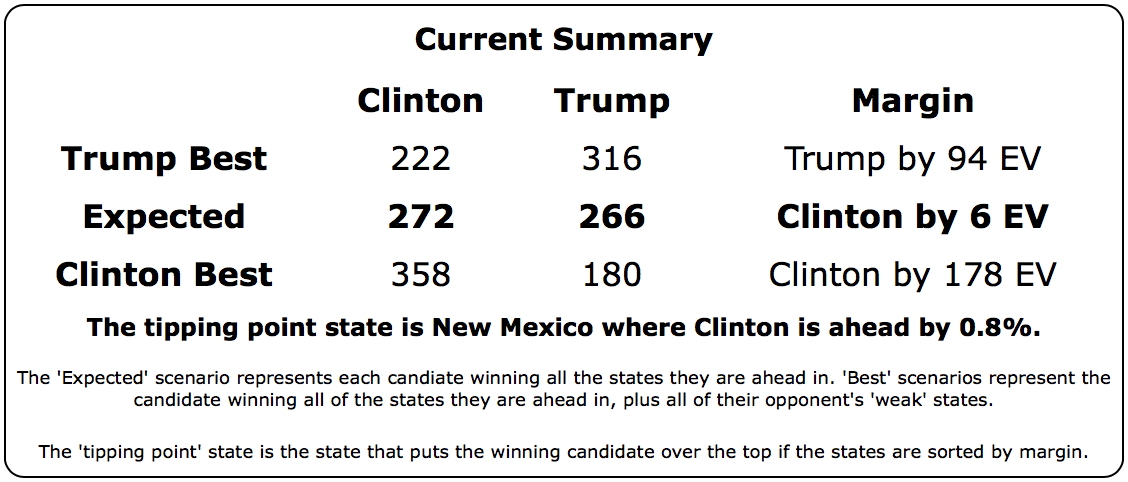
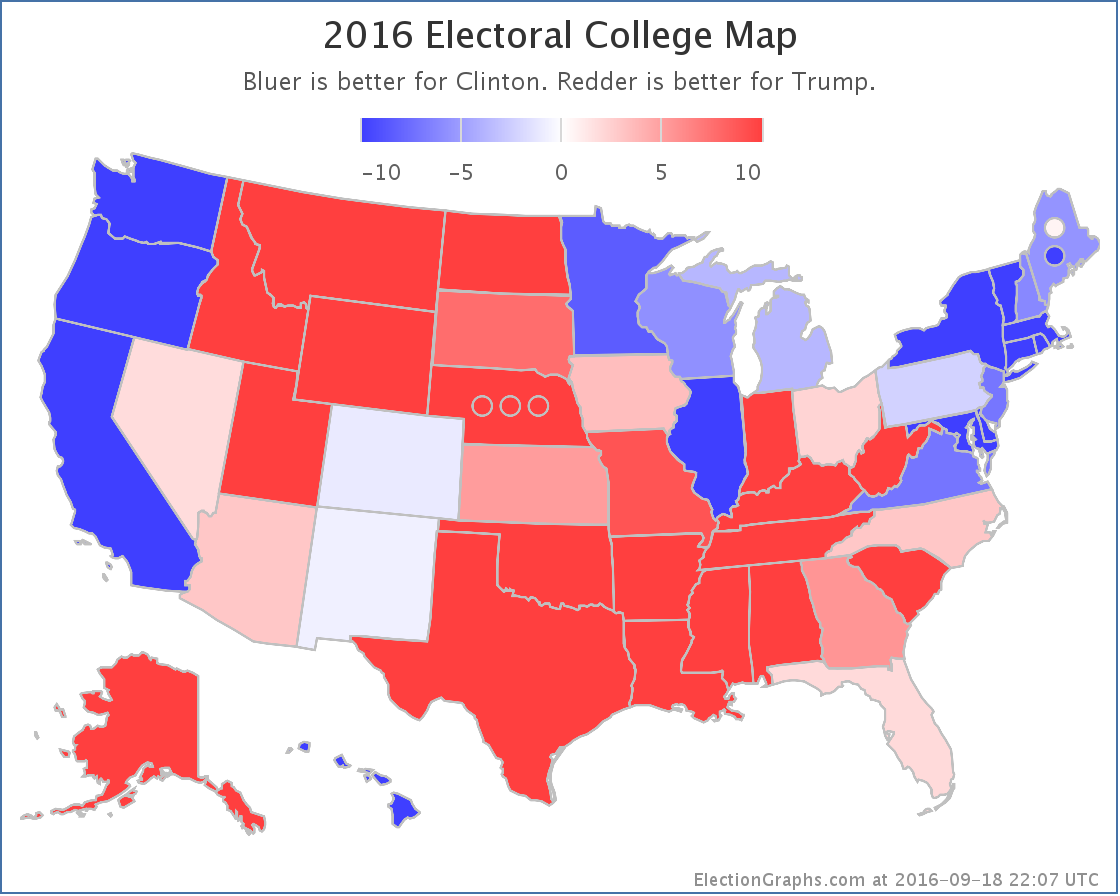
There is no denying this is now a razor thin race. This is close. If the election was held today, it could go either way.
Looking at the trends:
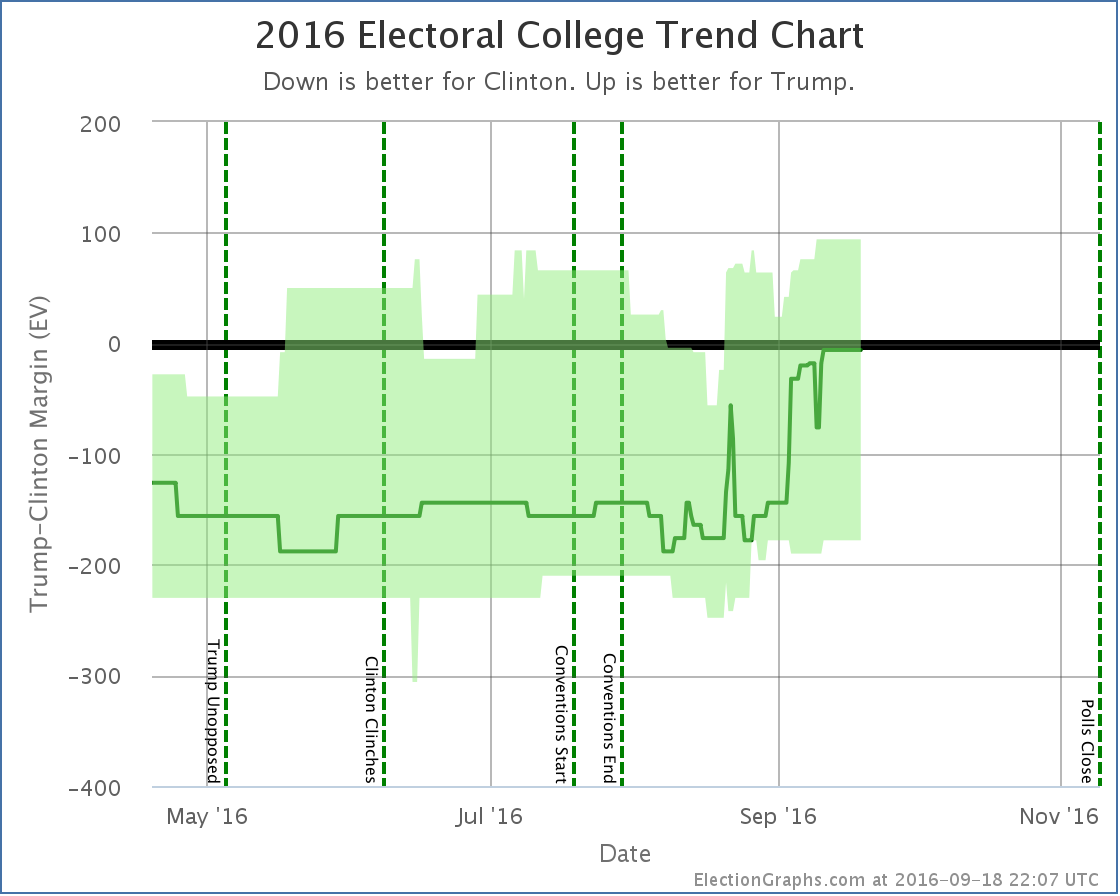
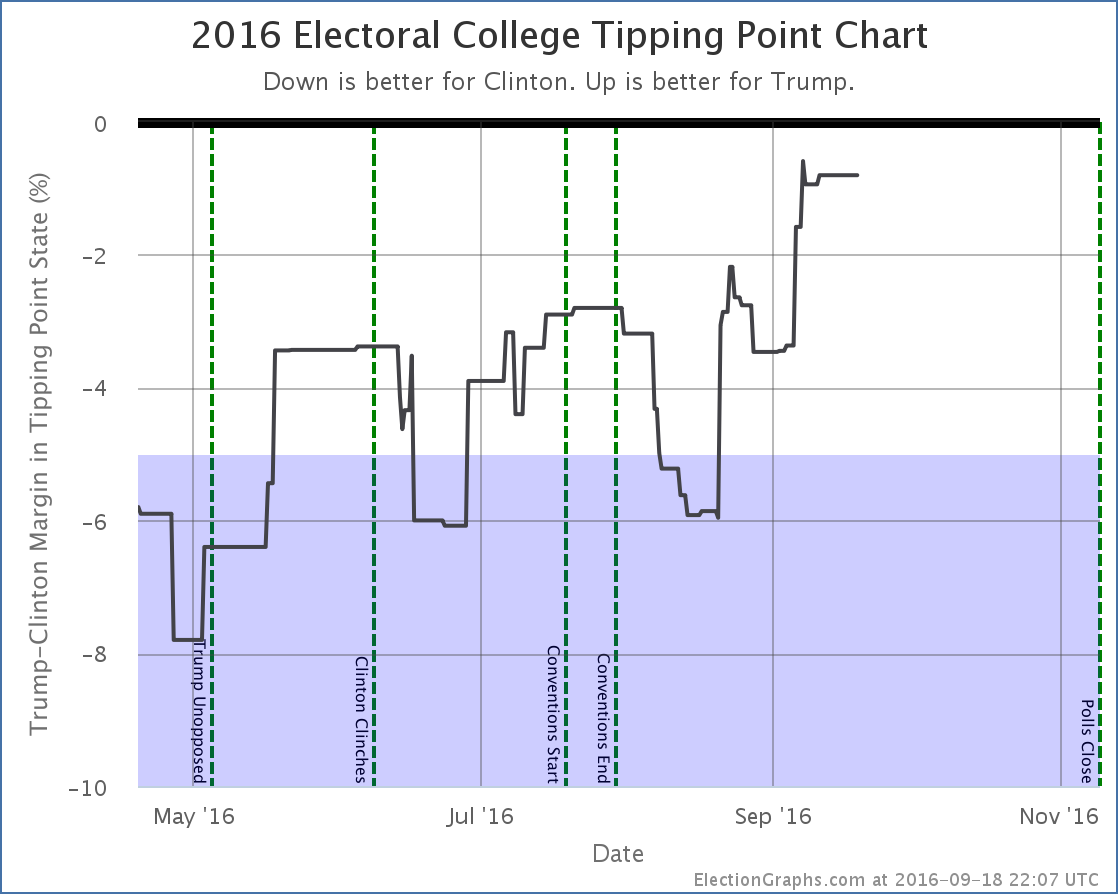
In both measures, Trump bottomed in mid-August and has been on a strong upswing ever since. Or is it that Clinton has been collapsing? In the end, the result is the same.
Trump is now far outside the “McCain to Romney” zone where he had been stuck. The question is if he is establishing a new normal, with many people permanently converted to his cause, or if this is an unsustainable high that will soon undergo reversion to the mean.
The race is not today. There are 51.0 days until we start getting the first real election results. A lot will happen between now and then. The first debate is now less than eight days away. Will it change anything? We shall see…
Individual States
I won’t provide individual commentary on all of these, but for those wanting to see the details on the states that changed the national summary this time around, here they are. Click through on any chart for the full detail page with individual polls listed.
Moving from Clinton to Trump:
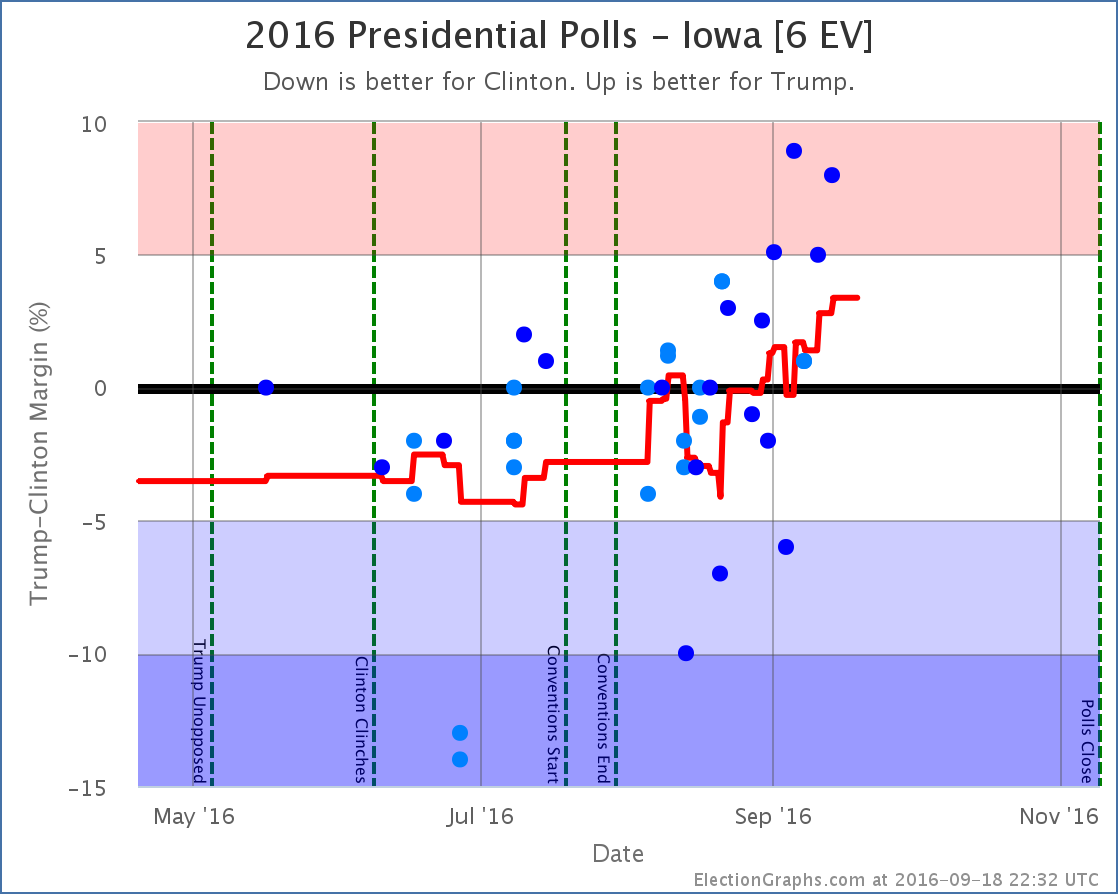
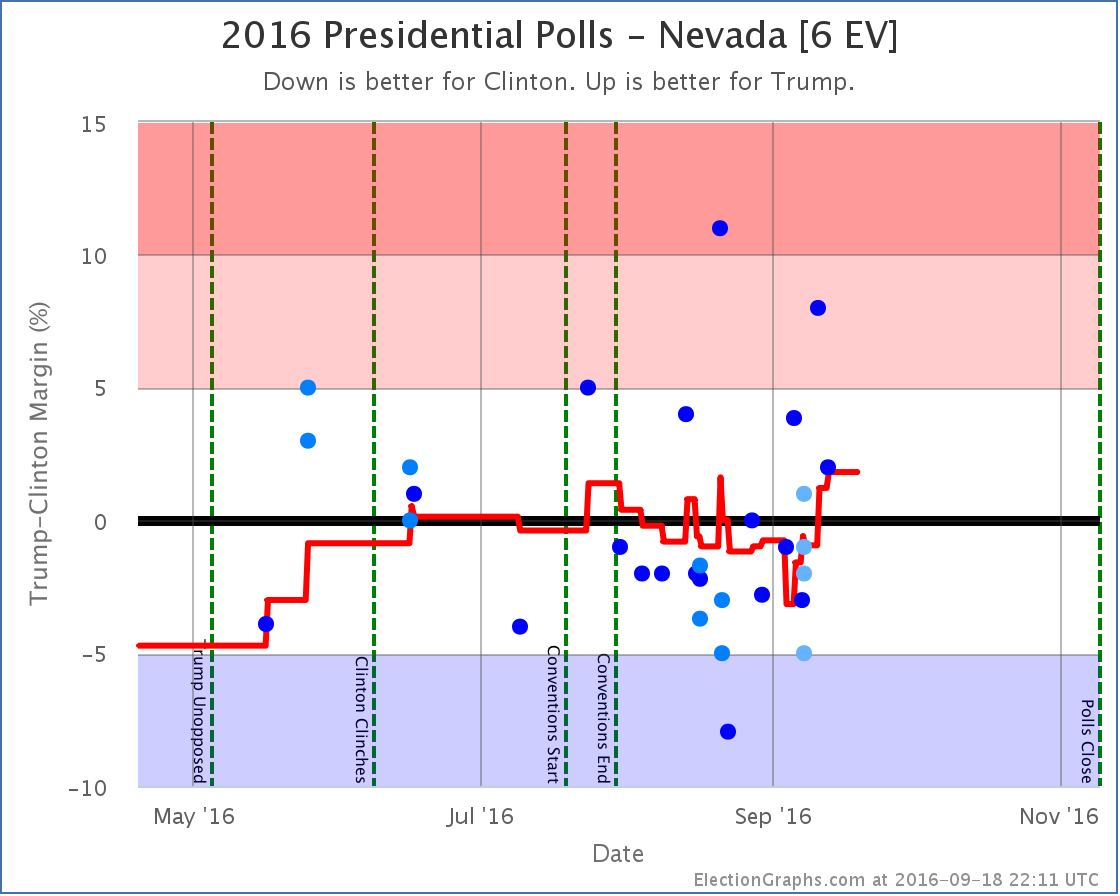
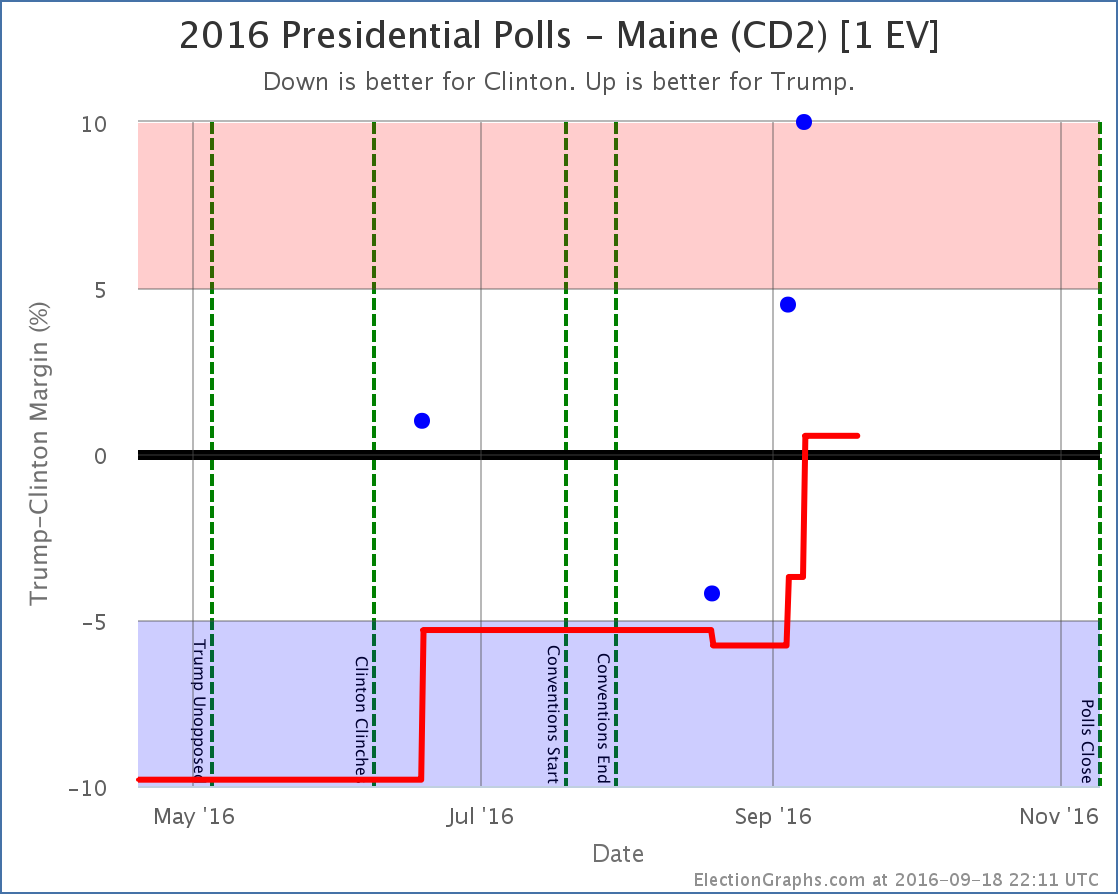
Now close enough to be in play for Trump:
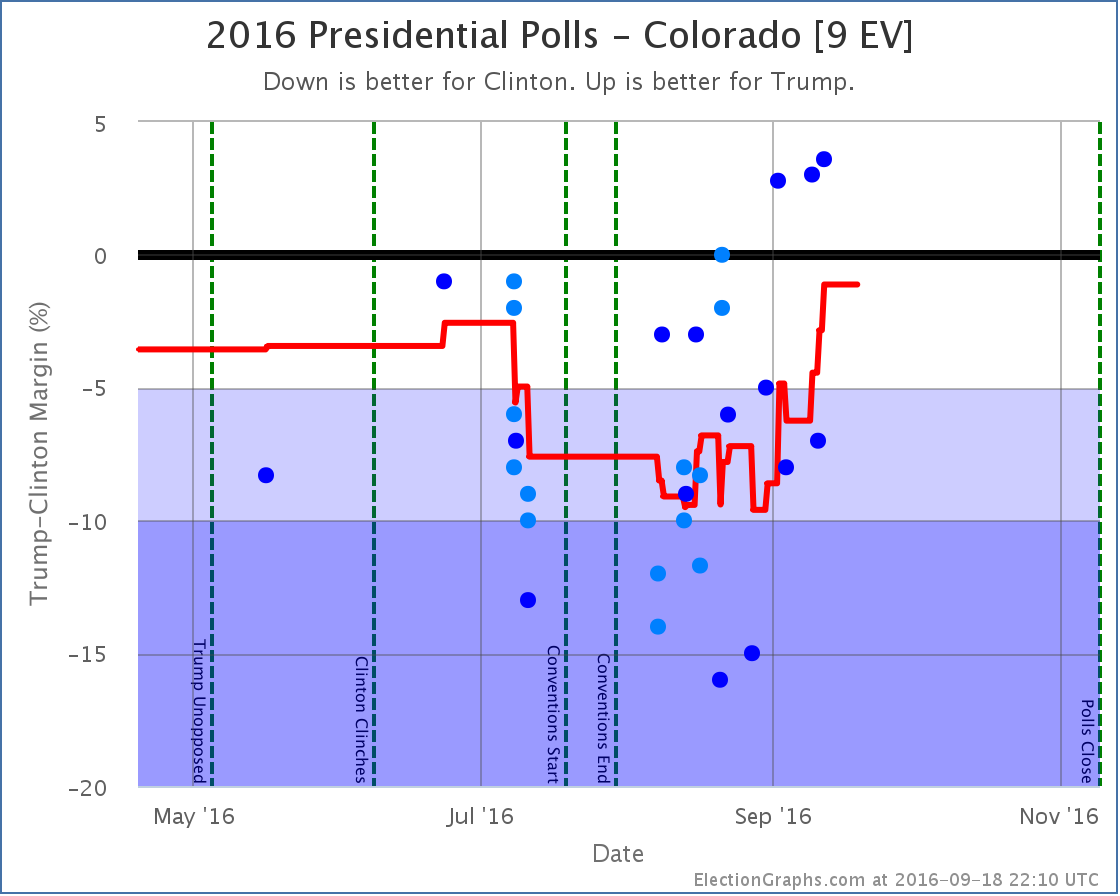
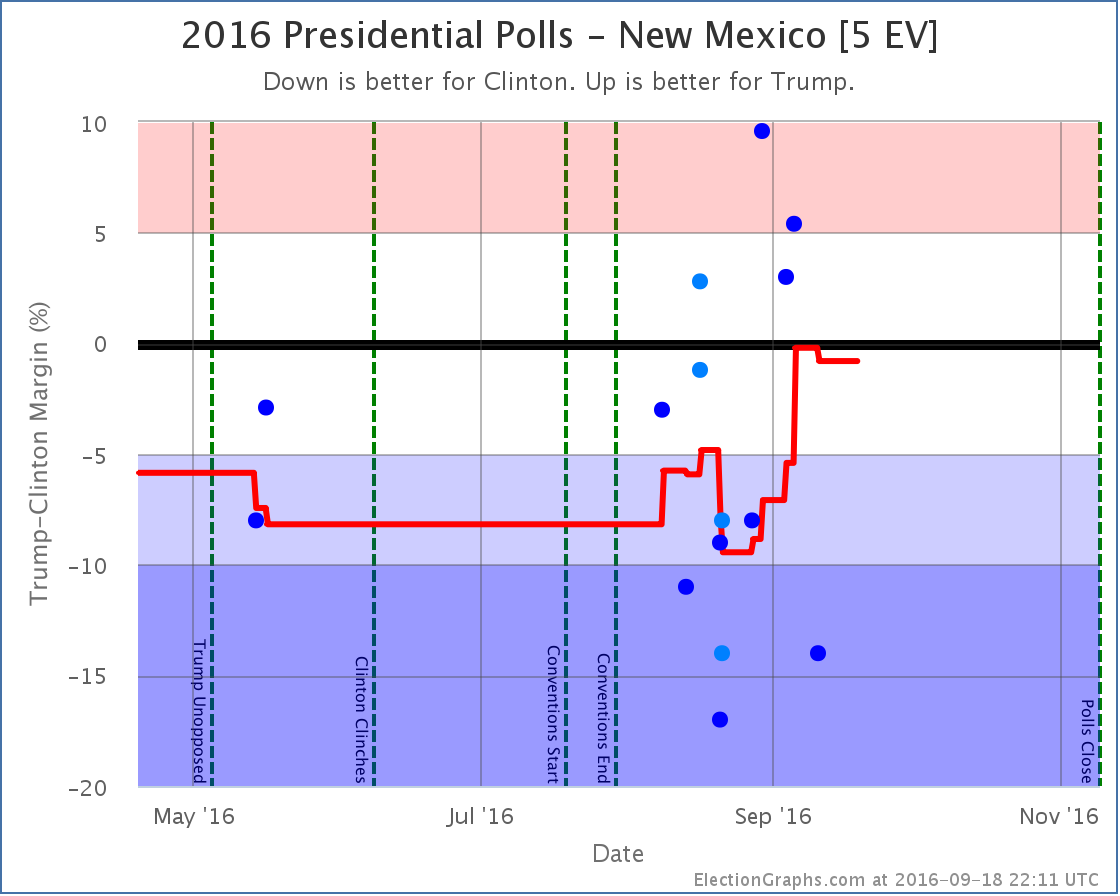
No longer close enough to be in play for Clinton
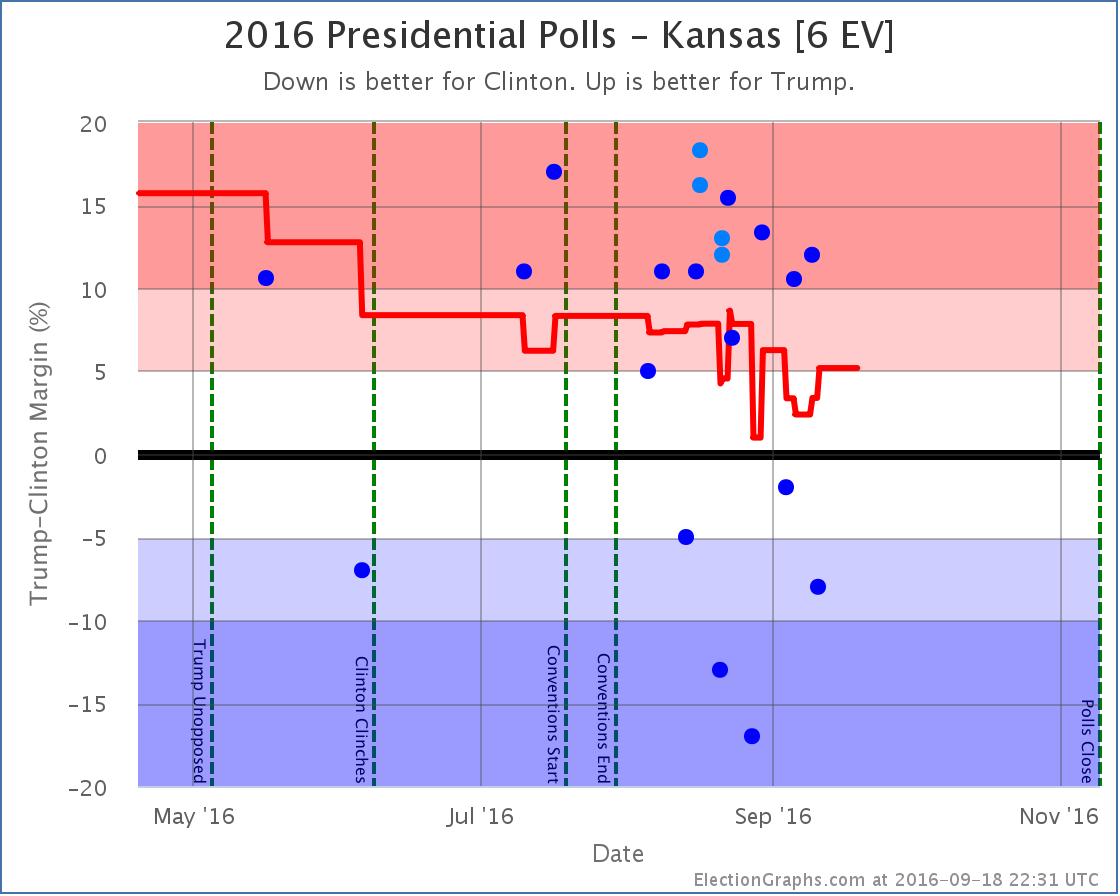
Another state whose movement influenced the tipping point
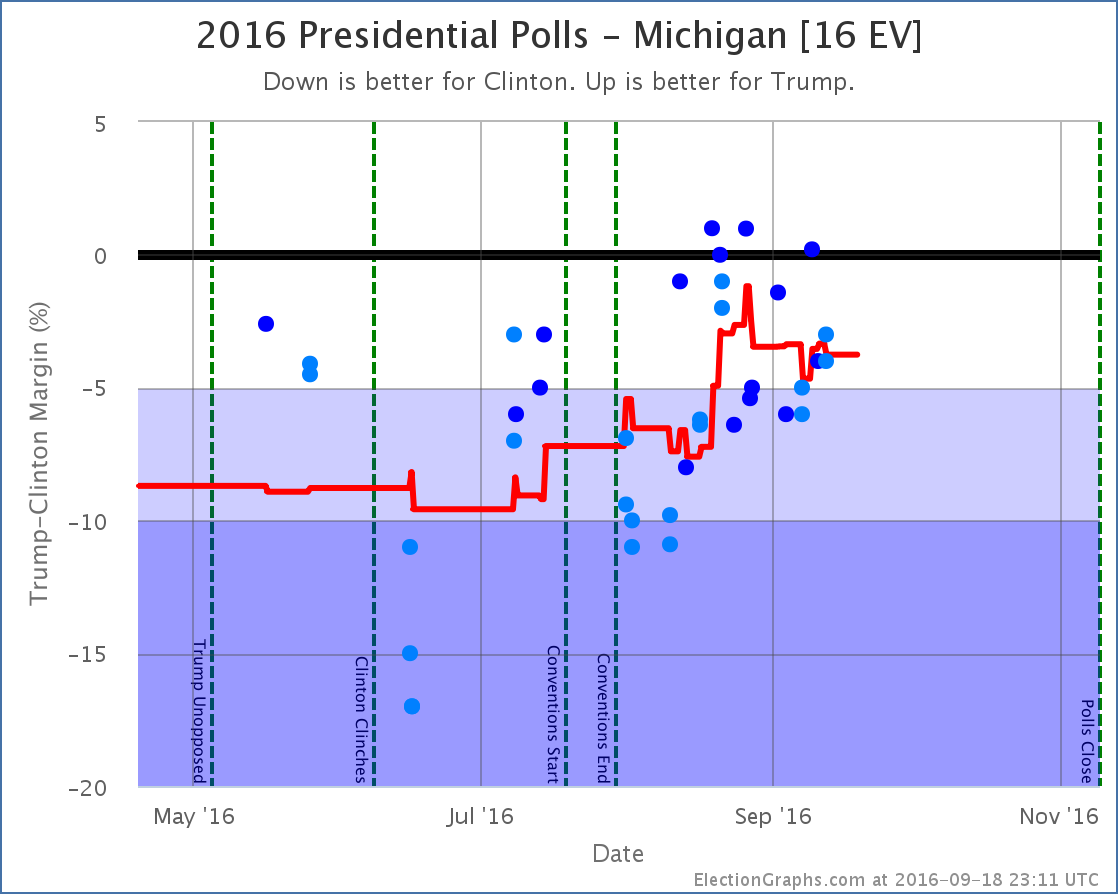
Note on “50 State” polls
Since Election Graphs tries to be as inclusive as possible with polls, we are including some “50 state” polls that some other folks have decided to exclude because of various methodological concerns. Others, like 538, include these polls, but give them very low weights in their models. Because Election Graphs tries to “keep it simple” we don’t do that kind of weighting. Everything just counts and we do a straight average.
Two of these “50 state” polls are now producing weekly results, Google Consumer Surveys and Reuters/Ipsos.
Honestly there are some crazy things in there. For instance:
- Google thinks Clinton is leading in Kansas, some weeks by a very large margin. No other pollster has seen this. Everybody else shows a significant Trump lead.
- Google thinks Trump is only 7% behind in DC. In DC? Really? In DC Obama beat Romney by 83.6% and McCain by 85.9%. The idea that Clinton is only 7% ahead of Trump in DC is pretty much ludicrous.
- The last few Ipsos polls have shown a Trump lead between 13% and 23% in Texas. The most favorable poll to Trump other than Ipsos has a 11% Trump lead, and most show it significantly narrower than that.
- In general it seems to be very common for these two polls to produce results which are outliers compared to other pollsters… Sometimes they show a result far more favorable to Clinton than anyone else, sometimes far more favorable to Trump than anyone else. The direction isn’t uniform, they just sometimes seem way off the mark.
- In many states the sample sizes are very low, and you see wide swings. For instance in West Virginia the Google poll moved from Trump +29% to Clinton +1% in one week! Yes, when you average them you get a 14% Trump lead, which is probably reasonable for West Virginia… but still!
- There are more examples, but you get the idea. In most states, these polls give roughly the results you would expect, in line with other recent polling, but occasionally, especially in smaller states, they seem to be clear outliers.
The craziness of some of these polls leads me to sometimes question my tenets of including everything and keeping it as close to a straight average as possible. But we’re sticking with that and we will see how it does.
And even with this the general notion of this site, that even with very simple assumptions you end up with similar results to what folks with complex models get seems to be holding up. Although the exact state by state results may differ slightly, every analysis I have read has the same general conclusion right now. The race is now much much closer than it was, although Clinton retains a narrow lead.
While these polls are a bit crazy, in the competitive states there are enough other polls so the average seems to be at least somewhat resilient when outliers like these pop up. And in the non-competitive states, well, these 50 state polls may be the only data in the average, so they may screw up the margins a bit, but in the end it doesn’t change the status of the state.
For more information…
This post is an update based on the data on ElectionGraphs.com. Election Graphs tracks both a poll based estimate of the Electoral College and a numbers based look at the Delegate Races. All of the charts and graphs seen in this post are from that site. Additional graphs, charts and raw data can be found there. Follow @ElectionGraphs on Twitter or like Election Graphs on Facebook to see announcements of updates or to join the conversation. For those interested in individual general election poll updates, follow @ElecCollPolls on Twitter for all the polls as they are added. If you find the information in these posts interesting or useful, please consider visiting the tip jar.
Trump clinched the nomination a week and a half ago but there were a few more contests left. CA/NJ/SD/MT/NM have now weighed in with their 303 delegates. Trump got all 303. As an unopposed candidate at this point, this is not unexpected.
And while the Democrats still have DC left, this is the end of the primary process on the Republican side. There are still 18 uncommitted delegates whose preferences are unknown, but their decisions at this point won’t change much.
Lets look quickly at the updated graphs:
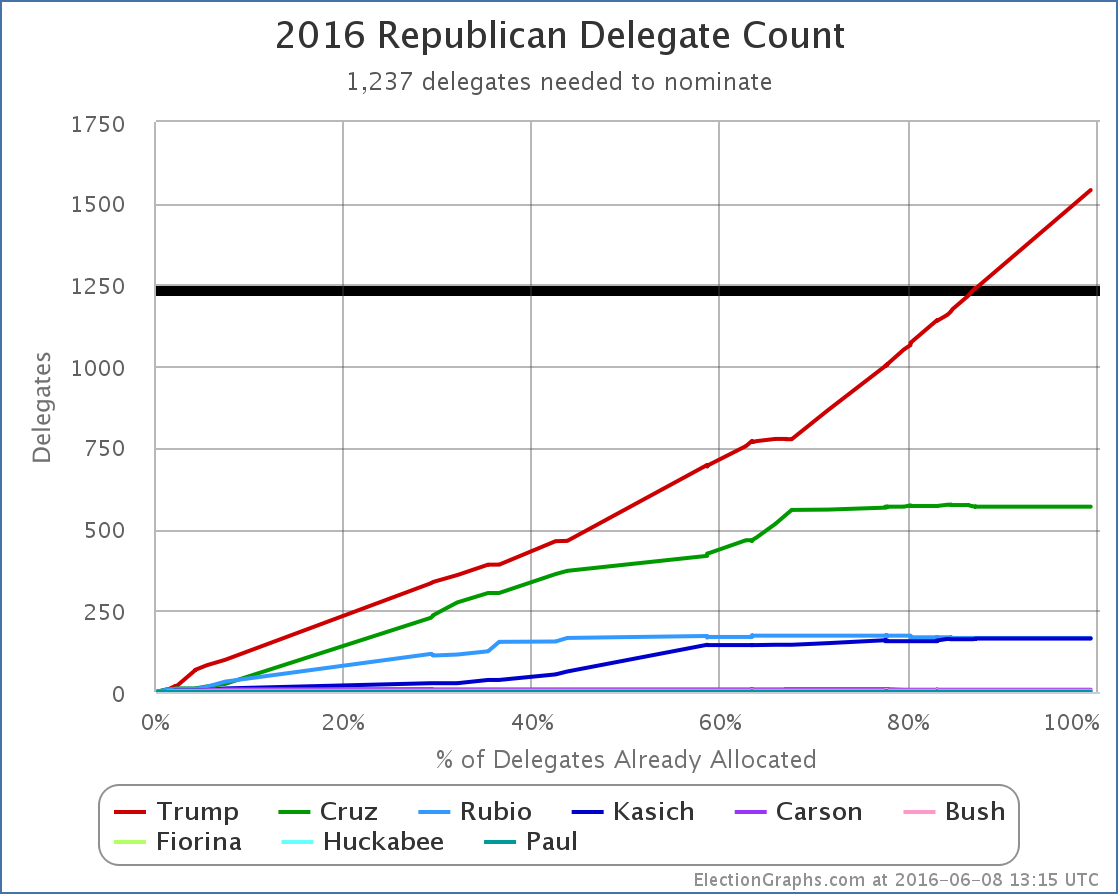
With this update Trump moves from just barely over the “magic number” to well over it with plenty of room to spare. The delegate count is now: Trump 1541, Cruz 569, Rubio 166, Kasich 164, Carson 7, Bush 4, Fiorina 1, Huckabee 1, Paul 1.
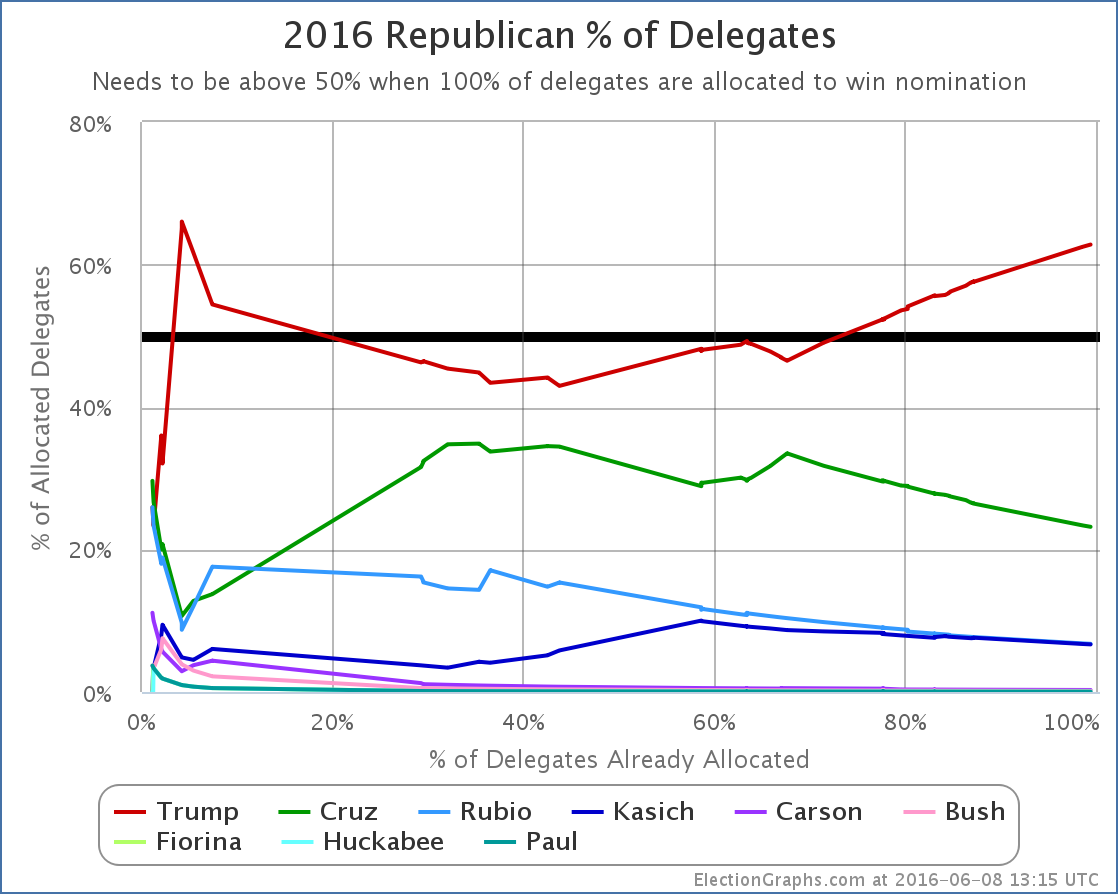
Trump now has 62.80% of the delegates allocated so far.
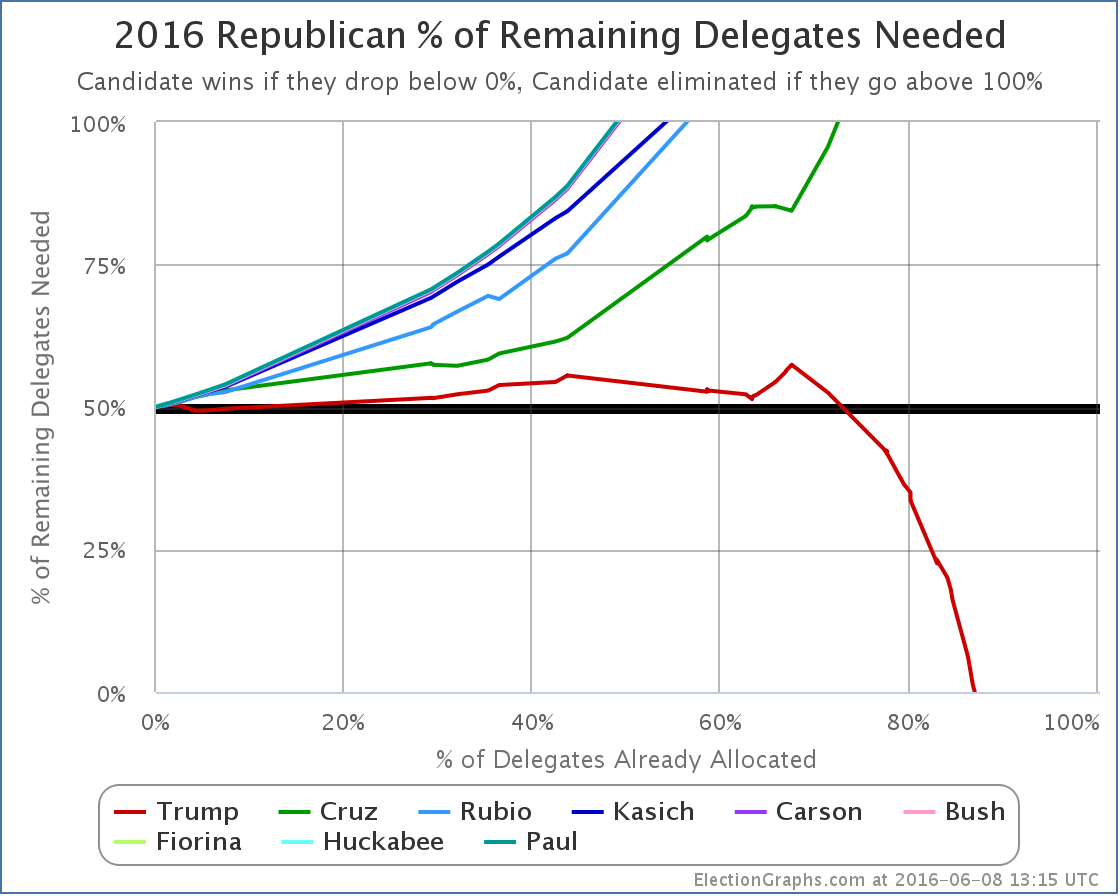
And just for reference, the “% needed to win” in final form.
There isn’t much more to say since this race is over minus any unexpected craziness. If there are any additional developments of note, we’ll update accordingly, but none is expected at the moment.
Time to concentrate on the general election.
Update 2016-06-30 06:00 UTC – Update from Vermont. Net change Kasich -1, Paul +1. (A Kasich delegate who considered themselves free after Kasich dropped out pledged his support to Paul.)
Update 2016-07-20 07:19 UTC: Final Election Graphs estimate was Trump 1541, Cruz 569, Rubio 166, Kasich 163, Carson 7, Bush 4, Paul 2, Fiorina 1, Huckabee 1, TBD 18. We now have the official roll call from the Republican National Convention: Trump 1725, Cruz 484, Kasich 125, Rubio 123, Carson 7, Bush 3, Paul 2, DNV 3. Differences were due to the application of rules in some states requiring all votes to go to candidates that were actually nominated (only Trump was officially nominated at the convention) and movement of additional uncommitted delegates to Trump.
Note: This post is an update based on the data on ElectionGraphs.com. Election Graphs tracks both a poll based estimate of the Electoral College and a numbers based look at the Delegate Races. All of the charts and graphs seen in this post are from that site. Additional graphs, charts and raw data can be found there. Follow @ElectionGraphs on Twitter or like Election Graphs on Facebook to see announcements of updates or to join the conversation. For those interested in individual general election poll updates, follow @ElecCollPolls on Twitter for all the polls as they are added. If you find the information in these posts interesting or useful, please consider visiting the tip jar.
By the Election Graphs count, Clinton now has 2745 delegates, which puts her well over the 2383 require to clinch the nomination.
As they did with the Republicans, AP went out and called many still publicly uncommitted superdelegates and was able to get the winning candidate to the magic number in their count a little earlier than those of us only using public commitments. In this case AP made their announcement Monday. The count here went over the magic number within minutes of the polls closing in New Jersey Tuesday night.
As of the writing of this post, all but 4 straggling delegates from New Jersey out of the 694 delegates up for grabs last night seem to be reasonably determined, so lets run down then numbers.
After Puerto Rico, Clinton only needed 5.05% of the remaining delegates to win. Sanders needed 95.19% of the remaining delegates. Clinton needed 43 delegates, Sanders needed 811.
In CA/NJ/NM/MT/SD/ND Clinton got 391 delegates while Sanders got 299. (As mentioned, there are still 4 TBD from NJ as of this writing.)
In the days between Puerto Rico and the June 7th results coming in, superdelegate changes yielded a net change of: Clinton +14, Sanders +1, O’Malley -1. Yes, that lone O’Malley superdelegate finally flipped… to Clinton.
Total change since Puerto Rico: Clinton +405, Sanders +300, O’Malley -1
That is Clinton 57.53%, Sanders 42.61%. (Adds to more than 100% because Clinton took the one delegate from O’Malley.)
So Clinton met her target, Sanders did not.
405 delegates is significantly more than the 43 delegates Clinton needed to go over the top.
She clinches. She is the presumptive nominee.
Lets check out the updated graphs:
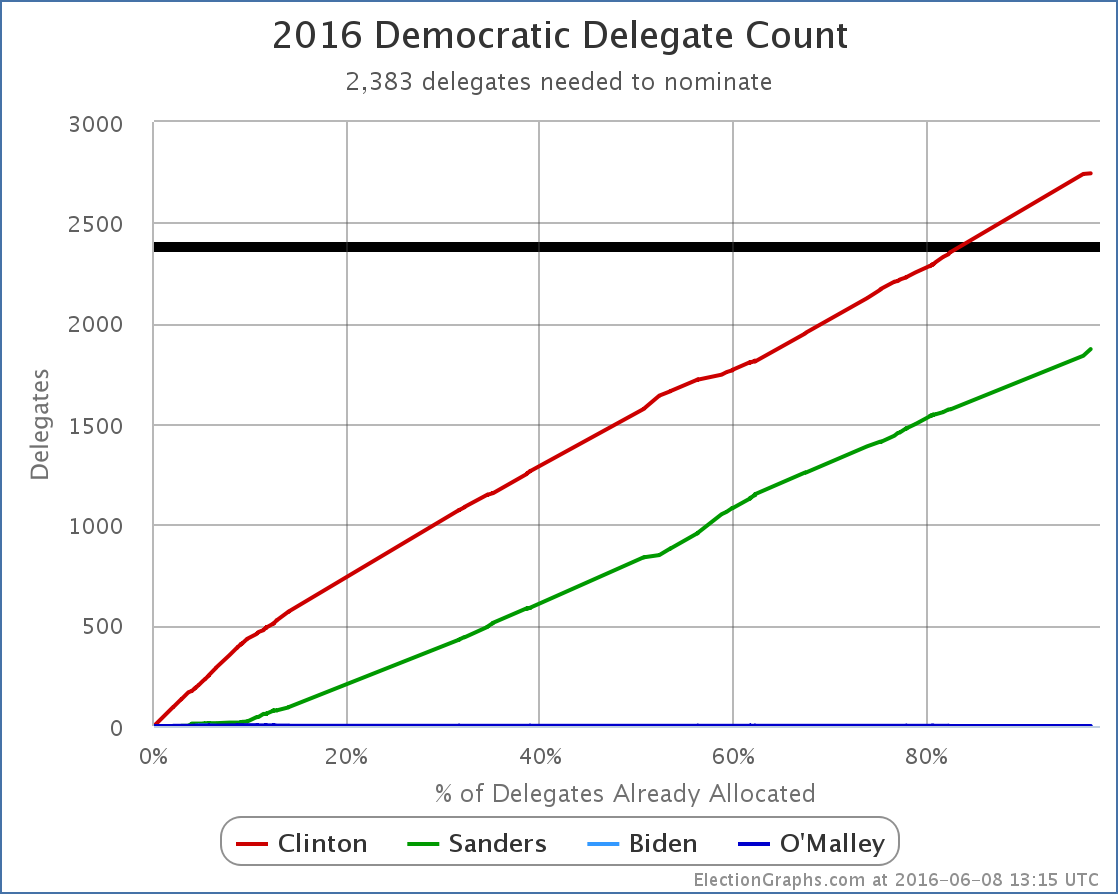
New delegate totals: Clinton 2745, Sanders 1872. Clinton blows past 2383 and is now well beyond where she needed to get.
There are 148 delegates left. Washington DC has 20 up for grabs next week. There are those 4 from New Jersey too. The other 124 are superdelegates who have not yet stated a preference. Clinton needs none of these delegates. Sanders could get every single one of these delegates, and would still lose decisively.
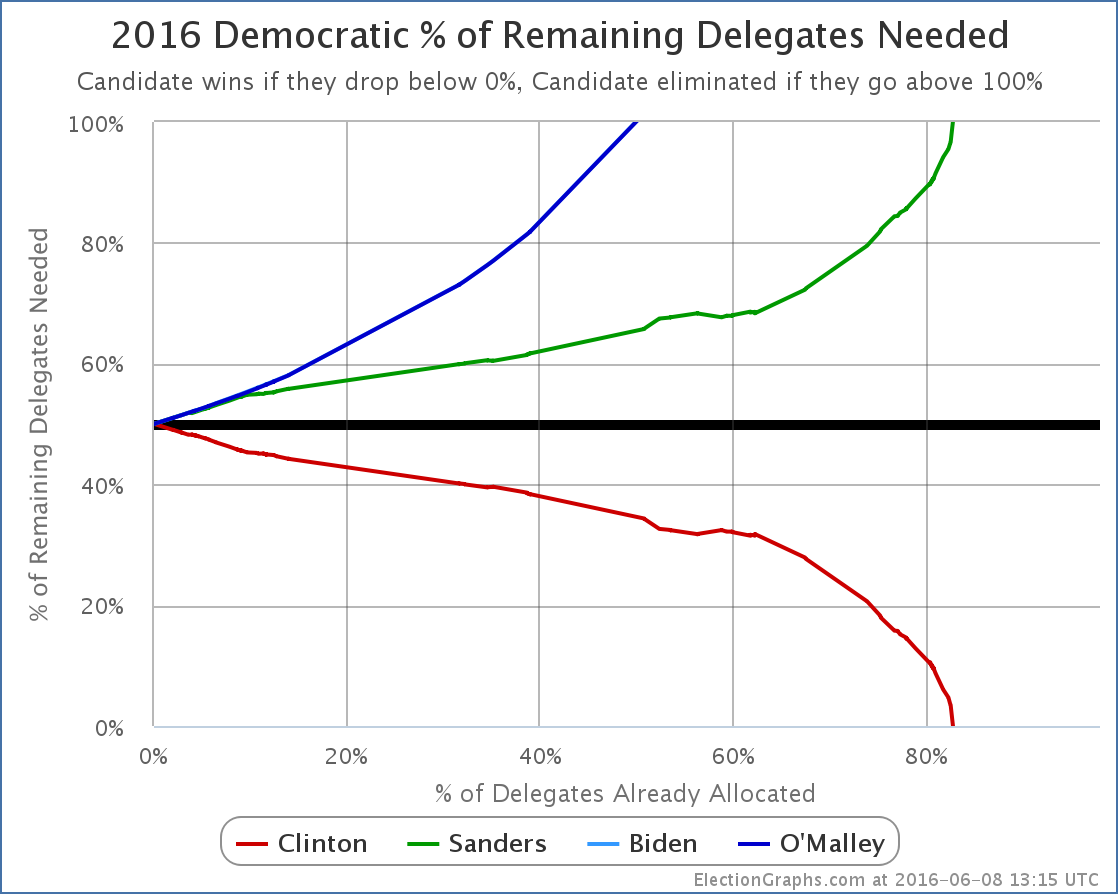
The “% of delegates needed to win” chart is complete. Clinton dropped below 0%, Sanders went above 100%.
One more graph:
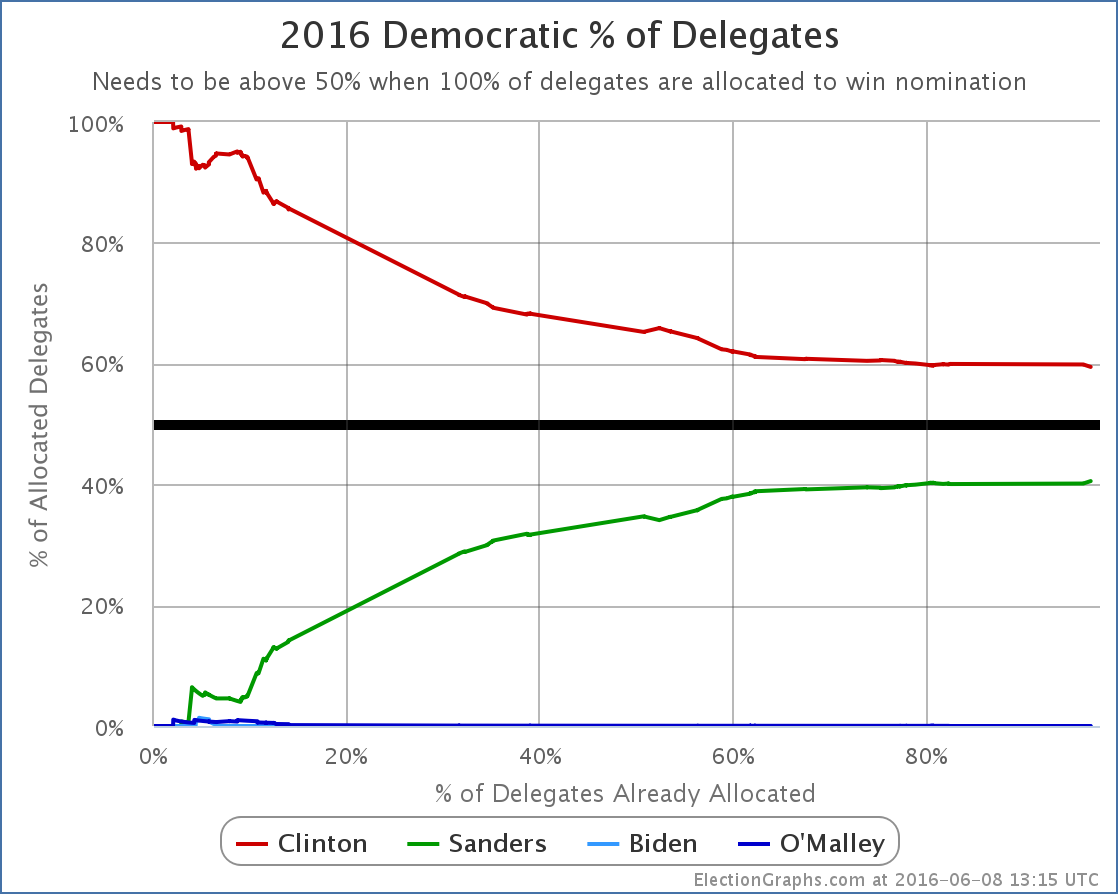
Since she started at 100% of the delegates by getting superdelegates before the first primaries or caucuses even happened, Clinton’s “% of delegates” number of course trended downward through most of the cycle. But for quite some time now the delegate race has stuck pretty close to being a 60% to 40% split in Clinton’s favor. As of now, it sits at Clinton 59.45%, Sanders 40.55%.
OK, now to step back a little…
Clinton dominated this race from the beginning. There were only a handful of moments where Sanders even managed to close the gap a little bit. Sanders was never even close. It was clear since the beginning of March… at the latest… that is being generous… it was fairly clear even before that… that Sanders catching up would take a miracle. The one thing that has been amazing throughout the primary process is the ability of many Sanders supporters to be in complete denial about this in the face of overwhelming evidence. It is one thing to be enthusiastic about your candidate and even to hope for that miracle, but it is another thing to not even recognize that you are losing and that it would indeed take that miracle to win.
And yes, some of those Sanders folks are still in denial even now. Because superdelegates. So a quick look. Right now we have Clinton 2745, Sanders 1872. There are 124 remaining superdelegates. Lets give them all to Sanders. For fun give Sanders all 20 DC delegates and the 4 from New Jersey too. Now we have Clinton 2745, Sanders 2020. All delegates are now allocated. Sanders is still short. To get to 2382 he would need at least 182 delegates who have committed to Clinton to change their minds and vote for Sanders instead. Clinton has 532 superdelegates by the latest count. So that means 34.2% of the superdelegates currently committed to Clinton would have to flip.
They would have to do that flip in the face of Clinton having won the popular vote (even if you include estimated popular vote for caucus states), Clinton having won the pledged delegate count, and Clinton having won the most states. Not to mention significant numbers of the superdelegates not simply being lukewarm Clinton supporters, but being people who she has actively cultivated for many years, a good number of which have actually been active in her campaign.
Is it mathematically possible? Yes. Of course it is. Is it going to happen absent something catastrophic happening to Clinton? No.
Some Sanders folks are still holding out the “What if Clinton is indicted?” scenario. My guess is most superdelegates would consider it an unfair and unjust indictment and stick by their candidate. It probably wouldn’t be enough. Perhaps I suppose. It is a stretch though. More realistically it would take a debilitating health issue or some brand new scandal so serious it dwarfs everything that has come up so far. Can you imagine these sorts of things? Of course. But they are all unforeseen unpredictable types of event, not things you decide to continue a campaign based on. After all, there are ways Martin O’Malley can still win the nomination too!
You can conjure similar scenarios on the other side too of course, but absent that kind of craziness, we now have our nominees in both parties.
So we have Clinton vs Trump. Time to start focusing on the general election analysis!
153.4 days until polls start to close on election day!
Update 2016-06-12 17:16 UTC – Superdelegate update. Net Change: Clinton +11
Update 2016-06-12 17:43 UTC – Missed one change in the superdelegate update above. Additional Change: Clinton -1. (So Clinton +10 for this day’s scan.)
Update 2016-06-12 18:02 UTC – Updates from California, New Jersey, and South Dakota (including the remaining 4 TBD delegates from New Jersey). Net change: Sanders +4.
Update 2016-06-15 01:40 UTC – Superdelegate update. Net Change: Clinton -3, Sanders +1.
Note: This post is an update based on the data on ElectionGraphs.com. Election Graphs tracks both a poll based estimate of the Electoral College and a numbers based look at the Delegate Races. All of the charts and graphs seen in this post are from that site. Additional graphs, charts and raw data can be found there. Follow @ElectionGraphs on Twitter or like Election Graphs on Facebook to see announcements of updates or to join the conversation. For those interested in individual general election poll updates, follow @ElecCollPolls on Twitter for all the polls as they are added. If you find the information in these posts interesting or useful, please consider visiting the tip jar.
Edit 15:19 UTC to mention the 4 delegates from New Jersey in the list of remaining delegates and the calculations for superdelegates flipping.
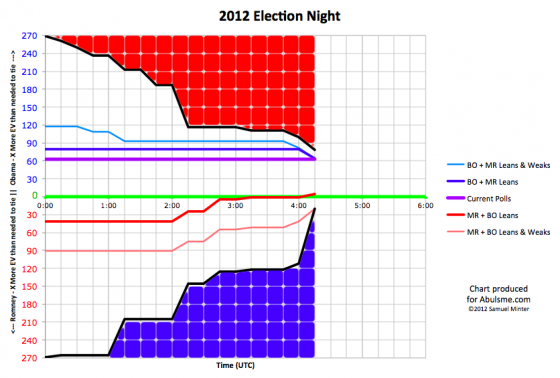
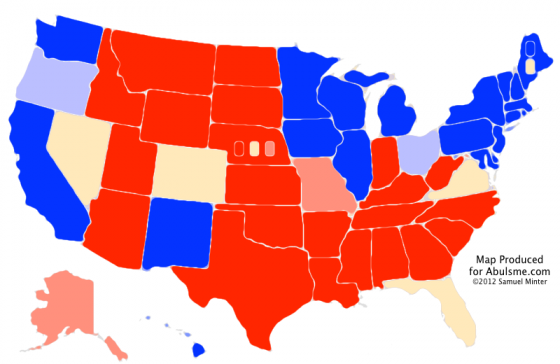
|
Romney |
Obama |
| Romney Best Case |
264 |
274 |
| Current Status |
206 |
332 |
| Obama Best Case |
205 |
333 |
A bunch of states were called between 04:00 UTC and 04:15 UTC:
- Obama: CA, HA, WA, WI, IA NM
- Romney: ID, MT, NC
Only one of these mattered. Iowa. Iowa was a close state. Romney needed every close state he had left in order to win. Without Iowa, even if Romney swept every other close state (and Maine’s 2nd) he would only get to 264.
When CNN called Iowa at 04:09 UTC, I called the race on twitter in these two tweets. Nine minutes later when some more states came in, CNN called the election for Obama. They were slow. More on those next states in the next update.
Anyway, Obama wins reelection!
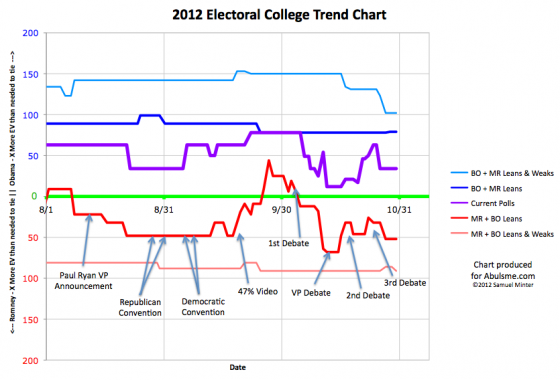
Minor change on the edges as New Mexico once again drops below a 10% Obama lead:
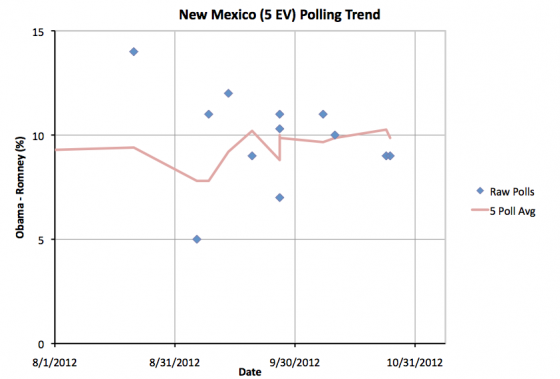
A few days ago Obama’s lead in the five poll average in New Mexico moved slightly above 10%, today a new poll pulls it back down to just below 10%. Either way, Obama will win New Mexico. So lets quickly move on so we can get to the good new stuff. First of all, new map and summary:
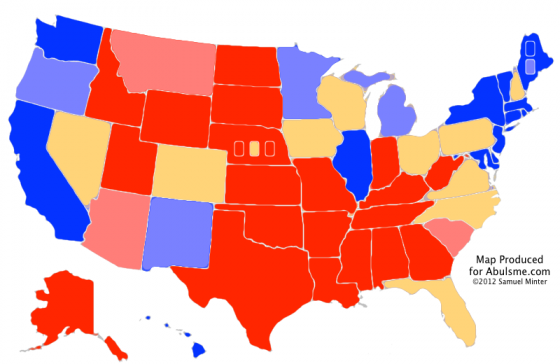
|
Romney |
Obama |
| Romney Best Case |
321 |
217 |
| Current Status |
235 |
303 |
| Obama Best Case |
190 |
348 |
While New Mexico is colored lighter blue on the map, the summary is unchanged from yesterday, since New Mexico wasn’t moving in or out of “swing state” status.
Since we still have a contest where Romney could win if he swept all the swing states, lets again look internally at how the polls stack up within the swing states, but rather than me listing the current margins in each of the swing states as I have done before, we’ll cut to the chase, and look at the “spiffy graph” I promised on Saturday. Graph first, then explaination:
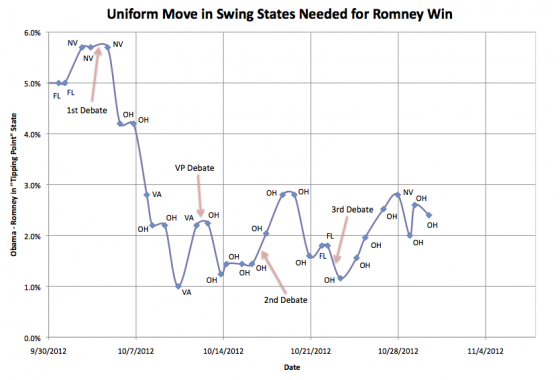
OK, in my recent posts I’ve listed the swing states, listed their margins, and then mentioned which states Romney would need to win if he took them “in order” by how well he is doing in the state. When you do this, one state would put Romney over the top. I then looked at the margin in that “Tipping Point” state. In other words, if Romney improved his margin by the same percentage across the board in all states (or at least all the swing states) how much better would he need to be doing in order to actually win enough of those states to win the electoral college?
I base these margins off my five poll average rather than something more sophisticated, but the general concept of this is similar to Sam Wang’s “meta-margin” at the Princeton Election Consortium. It shows another way of looking at the race, and one which gives a closer look at who is ahead and by how much than simply looking at the three model lines I usually present. With the three lines I normally present you can tell who is ahead and that it is relatively close, but it is hard to get a sense of exactly how FAR ahead the candidate in the lead is when it is “close”.
So anyway, what does this show? Well, basically the same trends we see in Romney’s Best case line and the current line. Namely, the first part of October Obama was in free fall, but that stopped around the time of the VP debate, and since then there has been a pretty noisy signal, but with a slight trend toward Obama. If you are generous to Romney, you can say that the trend has been flat since the VP debate, but any argument that there has been continuing Romney momentum is clearly false.
The “tipping point state” has almost always been Ohio, with a few days here and there when polling moved states slightly out of their normal order. But be it Ohio, or occasionally Florida, Virginia or Nevada, Obama’s lead in the tipping point state has been staying in a fairly consistent band between 1% and 3% for the past three weeks.
Obama is no longer in the comfortable territory he was in before the 1st debate, where Romney would have to move the tipping point states by more than 5% to win… a state I described before as Romney’s best case being to lose. But he has a buffer there, and, so far at least, the key tipping point states are not showing the moment Romney would need in order to win.
Now, if something were to happen to induce a move as large as the decline Obama had at the beginning of October, then yes, that would potentially still be enough to flip the race. As I type these words though, there are 7 days and 55 minutes until the first polls close on election day. There is very little time left for a last minute change large enough to flip this to Romney.
It could happen, it is just becoming a bigger and bigger stretch with every day that goes by that does not move things dramatically in Romney’s direction.
Meanwhile of course, even while NO electoral college model that I’ve seen has put Romney ahead at ANY time in the past year, all the aggregators of national polls have shown Romney ahead for almost all of the last three weeks, and that lead continues today. If nothing happens to shake things up in the next seven days, the prospect of an electoral college / popular vote split seems to get more likely by the day.
Note: Chart and map from the Abulsme.com 2012 Electoral College Prediction page. Both assume Obama vs Romney with no strong third party candidate and show polling as it currently exists. Things will change before election day. On the map red is Romney, blue is Obama, gold states are too close to call. Lines on the chart represent how many more electoral votes a candidate would have than is needed to tie under several different scenarios. Up is good for Obama, Down is good for Romney.
Edit 2012 Oct 30 22:43 UTC to fix some wording issues.
Edit 2012 Oct 30 23:19 UTC to fix typo.
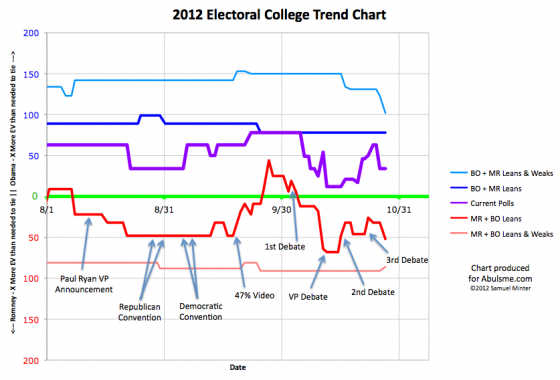
Four states change status today, three moving toward Romney, one moving toward Obama. On the surface this looks very good for Romney. We’ll look into why that might not be the case in a bit, but first lets look at the four states that move today:
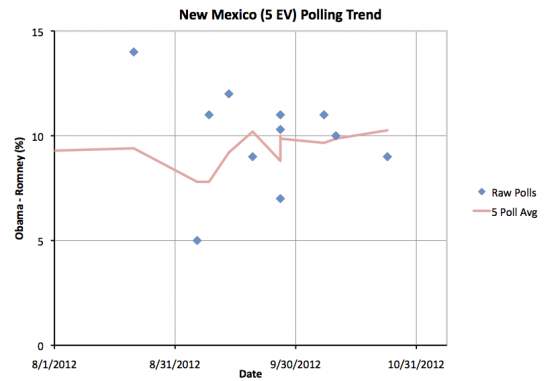
Very little to say about New Mexico. Obama’s lead increases slightly and is now over 10%. Obama will win New Mexico.
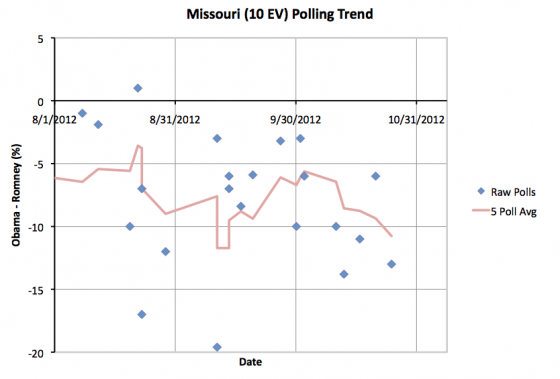
Not much to see in Missouri either. Romney’s lead increases slightly and is now over 10%. Romney will win Missouri.
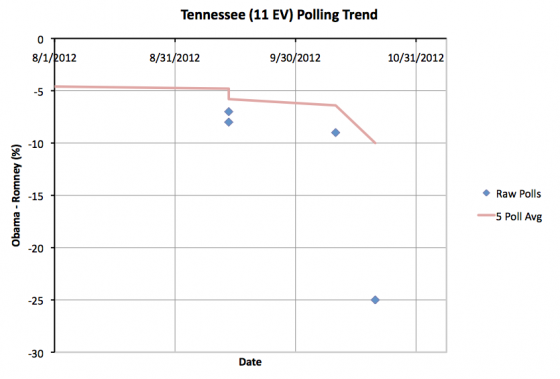
Tennessee is a bit odder. The new poll showing a 25% Romney lead in Tennessee looks like an outlier. No other poll in the state from the last year shows a Romney lead greater than 9%. Without this poll the five poll average has a Romney lead of 6.4%. With this, the Romney lead jumps to 10.0%, which moves Tennessee to the “Strong Romney” category. This may not be deserved, but I don’t make judgements about outliers, I just let the average sort it out. Either way, Tennessee’s not in contention this year. Romney will win Tennessee.
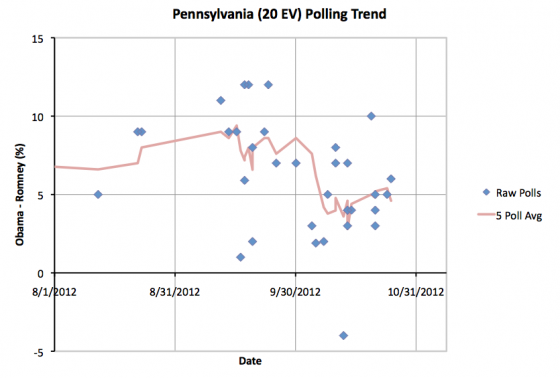
Pennsylvania shows Obama’s lead dropping under 5% again as an outlier showing Obama leading by 10% drops off. Again, we just let the average deal with outliers here, and that is what has happened. Pennsylvania returns to “Lean Obama” which probably better represents the true state of the race in Pennsylvania at the moment. Having said that, it is at the high end, Obama’s lead in the five poll average is now 4.6%. This is a pretty substantial lead. Any scenario that has Romney winning Pennsylvania would already have him wining the presidency handily.
OK, so this gives us this new map and summary:
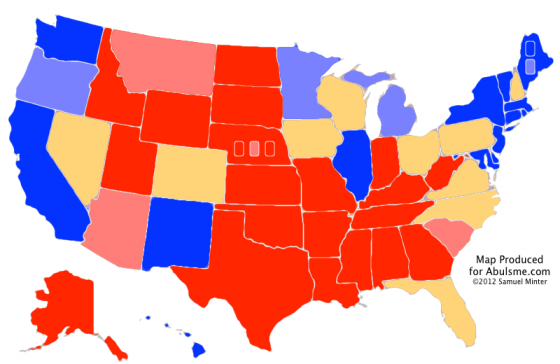
|
Romney |
Obama |
| Romney Best Case |
321 |
217 |
| Current Status |
235 |
303 |
| Obama Best Case |
191 |
347 |
As before though, since depending which way the close states go you could have either candidate winning, we need to look at the individual states:
- North Carolina (15 ev): 2.4% Romney lead – 4/5 polls after last debate
- Florida (29 ev): 0.8% Romney lead – 5/5 polls after last debate
- Virginia (13 ev): TIE – 5/5 polls after last debate
- Iowa (6 ev): 1.2% Obama lead – 2/5 polls after last debate
- New Hampshire (4 ev): 2.2% Obama lead – 2/5 polls after last debate
- Colorado (9 ev): 2.8% Obama lead – 5/5 polls after last debate
- Nevada (6 ev): 2.8% Obama lead – 5/5 polls after last debate
- Ohio (18 ev): 3.1% Obama lead – 5/5 polls after last debate
- Wisconsin (10 ev): 3.8% Obama lead – 3/5 polls after last debate
- Pennsylvania (20 ev): 4.6% Obama lead – 2/5 polls after last debate
Something interesting here, but I am running out of time to go into detail. Ohio is no longer the tipping point state! If you start adding these states up in order of how far away they are from Romney, you see that Romney’s clearest path to victory is now holding North Carolina and Florida, then pulling ahead and winning Virginia, Iowa, New Hampshire, Colorado and Nevada. If he does that, he wins 273 to 265.
So as of today, if he moves every state more than 2.8% toward him, Romney wins. But yesterday that percentage was 2.5%. Wednesday it was 1.6%. Tuesday it was 1.2%
I may make a spiffy graph of this with the next update, but for now just looking at those numbers, you can see that despite moving some states closer to him, Romney’s path to victory is slipping away. The states he needs to pull ahead in are instead slowly pulling away.
Note: Chart and map from the Abulsme.com 2012 Electoral College Prediction page. Both assume Obama vs Romney with no strong third party candidate and show polling as it currently exists. Things will change before election day. On the map red is Romney, blue is Obama, gold states are too close to call. Lines on the chart represent how many more electoral votes a candidate would have than is needed to tie under several different scenarios. Up is good for Obama, Down is good for Romney.
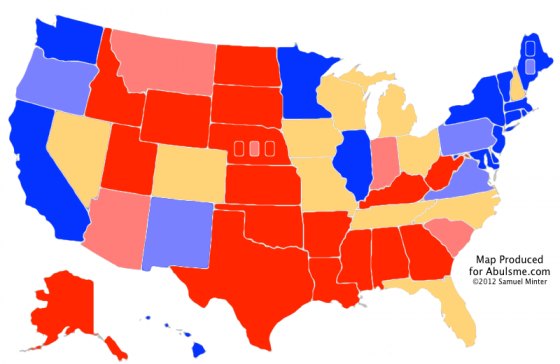
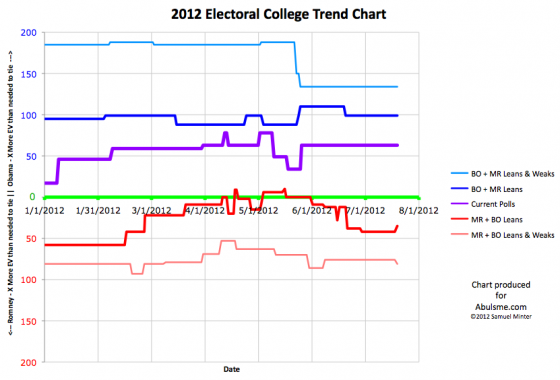
Chart and map from the Abulsme.com 2012 Electoral College Prediction page. Both assume Obama vs Romney with no strong third party candidate. Both show polling as it currently exists. Things will change before election day. On the map red is Romney, blue is Obama, gold states are too close to call. Lines on the chart represent how many more electoral votes a candidate would have than is needed to tie under several different scenarios. Up is good for Obama, Down is good for Romney.
We haven’t had an update to the status of any state in my model since June 29th. This is the longest stretch without an update since I started tracking this year’s electoral college race at the end of January. Now, the July 4th holiday was in the middle of that, and so polling was sparse for awhile, but still, there were plenty of polls, they just didn’t actually move states into new categories. Until today. We finally get three states moving today. Two move in Romney’s direction, one moves toward Obama.
So, in order by electoral weight:
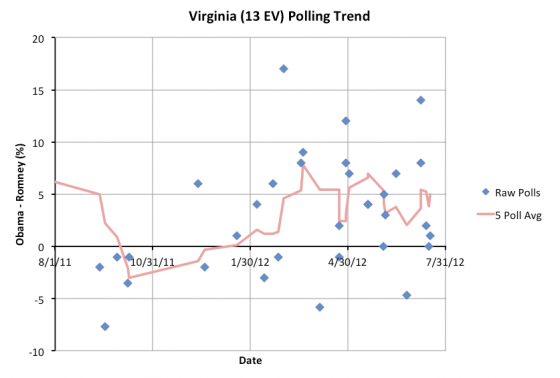
I added three new polls to the database for Virginia (13 ev) today and between them the five poll average pops up to exactly 5.0%, which puts Virginia back in the “Weak Obama” category, but just barely. The next poll could easily knock Virginia back into a less than 5% lead for Obama and make the state a swing state again. But for the moment, we take Virginia off the list of states where Romney has a shot.
One thing to note about the Virginia results. One of the new polls I added today was a PPP poll that ended July 8th that included the Constitution Party Candidate, Virgil Goode, who took 9% of the vote, mostly from Romney, which of course improves Obama’s position. Generally I find out about polls quicker than that, but today is the first day this one popped up in one of the sources I use regularly.
My policy generally is to use polls that include third parties as long as the people they include are definite candidates and not speculative. Goode was named the candidate for the Constitution Party back in April, so he counts. Because of this I also retroactively added another Virginia poll from April that included Goode. This changes the historical chart slightly, as that old poll expands Virginia’s previous experiment with being “Weak Obama” from having covered just May 26 to June 4th, to covering the longer period May 4th to June 8th. One should note of course that support for third party candidates typically collapses as election day approaches.
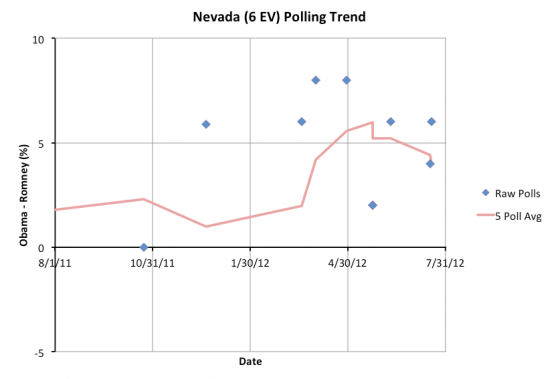
Next up is Nevada (6 ev). Recent polls show Obama’s lead slipping below 5%. So Nevada once again drops into swing state status. Obama’s lead in the five poll average is now 4.0%, which is not insubstantial, but is potentially within reach for Romney if events and the campaign narrative go his way. A 4% lead can disappear overnight with the right events in the news. So winning Nevada is once again considered part of Romney’s best case.
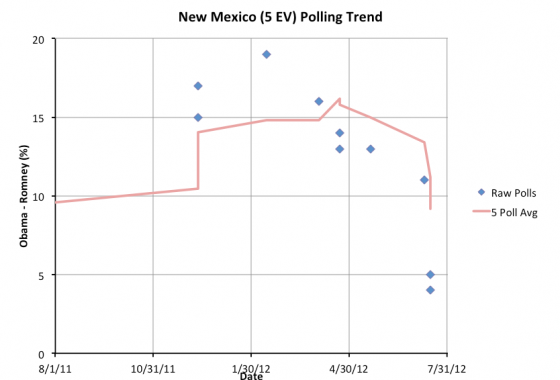
And finally New Mexico (5 ev). Obama’s lead in the five poll average drops under 10%, so I move it from “Strong Obama” to “Weak Obama”, but it is still not particularly close. Obama’s lead has to drop a lot more before it gets into swing state territory. Having said this, the last two polls in New Mexico are a very significant drop from earlier polls, and show things getting a lot closer. Both of these polls are from PPP though, one including Libertarian Gary Johnson, and one not including him. Since both polls are from one source, taken from the same underlying sample I believe, there is a chance they are outliers. We’ll have to wait for more polls to confirm. If this turns out to be real movement rather than sampling error, then this could be a pretty significant movement away from Obama in New Mexico.
So what does all this do to the overall situation? Well, New Mexico’s change does not effect the inventory of swing states, so it doesn’t affect the three main lines in our model at all. Nevada moves into swing status, but Virginia leaves it. Virginia is bigger, so today’s net effect is to make Romney’s best case worse by 7 electoral votes:
|
Romney |
Obama |
| Romney Best Case |
304 |
234 |
| Current Status |
206 |
332 |
| Obama Best Case |
170 |
368 |
So, as a whole, Obama wins today’s updates. But Romney still has a variety of paths to victory. Over the course of June, he took a lot of states Obama was ahead in by more than 5% and made them close. Virginia has hit 5% again, but just barely. That may be ephemeral. We have a ton of states that are close right now. True, most of them are still on Obama’s side of the line, and Obama still wins handily if he takes every state he is ahead in. But you have to make states close before you make them yours, and Romney has slowly but surely been doing that.
Romney did have a bad week last week, but state polls are sparse enough, it takes more than a few days of bad news for a trend to start showing up in the electoral college models. If the current status in Virginia gets confirmed by more polls, and other states start going that way too, then perhaps this is a start of a movement back away from Romney and toward Obama. But for the moment it is too early to tell.
Edit 2012 Jul 20 14:04 UTC: Actually updated the historical chart with the Virginia correction, which I’d neglected to do when this was first posted. Sorry!
|
|



















































